CTL assays
- 格式:doc
- 大小:21.00 KB
- 文档页数:1
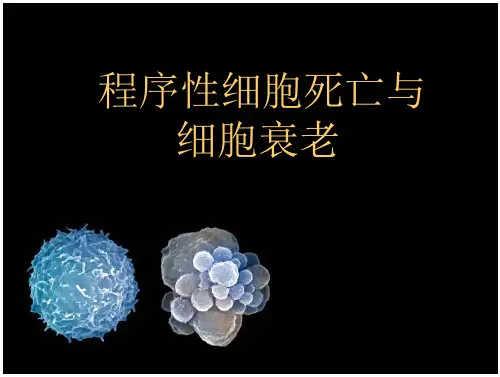
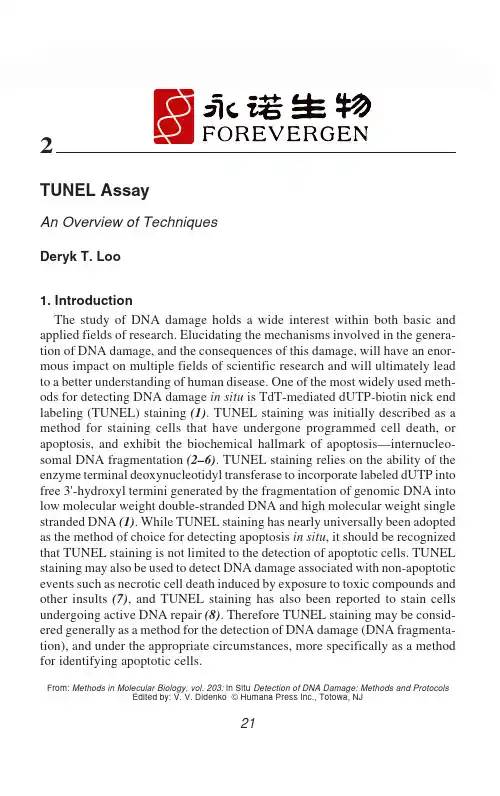
The goal of this chapter is to provide the reader with step-by-step protocols for in situ TUNEL staining of nuclear DNA fragmentation in both cultured cells and tissue sections. These basic TUNEL protocols have been used on a wide variety of cell types and tissues with success. Methods for both colori-metric and fluorescent staining of cultured cells and tissues is presented thereby allowing investigators to utilize the TUNEL staining procedure with a minimal investment in laboratory reagents and equipment. In addition, methods to modify and optimize the basic protocols, as well as troubleshooting and con-trol conditions, are provided in the Notes and Troubleshooting sections.2. Materials2.1. Cultured Cells1.Phosphate-buffered saline (PBS), pH 7.4.2.2% buffered formaldehyde: dilute high quality formaldehyde (v/v) in PBS priorto use.3.70% ethanol4.TdT equilibration buffer: 2.5 m M Tris-HCl (pH 6.6), 0.2 M potassium cacody-late, 2.5 m M CoCl2, 0.25 mg/mL bovine serum albumin (BSA). Aliquots may be stored at –20°C for several months.5.TdT reaction buffer: TdT equilibration buffer containing 0.5 U/µL of TdT enzymeand 40 pmol/µL biotinylated-dUTP (Roche Diagnostics Corp.; Indianapolis, IN).Prepare fresh from stock solutions prior to use.6.TdT staining buffer: 4×saline-sodium citrate (0.6 M NaCl, 60 m M sodium cit-rate), 2.5 µg/mL fluorescein isothiocyanate-conjugated avidin (Amersham Pharmacia Biotech, Inc.; Piscataway, NJ), 0.1% Triton X-100, and 1% BSA. Pre-pare fresh from stock solutions prior to use.7.Hoechst 33342 counterstain: 2 µg/mL in PBS (Molecular Probes; Eugene, OR).Stock solution may be stored at 4°C in the dark for several weeks.8.Vectashield antifade mounting medium (Vector Laboratories, Burlingame, CA).2.2. Tissue Sections1.Phosphate-buffered saline (PBS), pH 7.4.2.4% buffered formaldehyde: dilute high quality formaldehyde (v/v) in PBS priorto use.3.20 µg/mL proteinase K (Roche Diagnostics Corp.). Stock solution may be storedat–20°C for several months.4.95, 90, 80, and 70% ethanol in Coplin jars5.2% hydrogen peroxide . Prepare fresh from hydrogen peroxide reagent stock priorto use.6.2% BSA solution: 2% BSA (w/v) dissolved in PBS and passed through a 0.45 µmfilter. Sterile stock solution may be stored at 4°C for several weeks.7.2×SSC buffer: 300 m M NaCl, 30 m M sodium citrate. Stock solution may bestored at room temperature for several months.8.TdT Equilibration Buffer: 2.5 m M Tris-HCl (pH 6.6), 0.2 M potassium cacody-late, 2.5 m M CoCl2, 0.25 mg/mL BSA. Prepare from stock solutions. Aliquots may be stored at –20°C for several months.9.TdT Reaction Buffer: TdT E quilibration Buffer containing 0.5 U/µL of TdTenzyme and 40 pmol/µL biotinylated-dUTP (Roche Diagnostics Corp.). Prepare fresh from stock solutions prior to use.10.Vectastain ABC-peroxidase stock solution (Vector Laboratories, Burlingame, CA).11.3,3'-Diaminobenzidine (DAB) staining solution (Vector Laboratories).12.TdT staining buffer: 4×saline-sodium citrate (0.6 M NaCl, 60 m M sodium cit-rate), 2.5 µg/mL fluorescein isothiocyanate-conjugated avidin (Amersham Pharmacia Biotech, Inc.), 0.1% Triton X-100, and 1% BSA. Prepare fresh from stock solutions prior to use.13.Hematoxylin counterstain (Sigma-Aldrich; St. Louis, MO).14. Hoechst 33342 counterstain: 2 µg/mL in PBS (Molecular Probes). Stock solu-tion may be stored at 4°C in the dark for several weeks.15.Vectashield antifade mounting medium (Vector Laboratories).3. Methods (see Notes 1 and 2).A flowchart of the general protocol for TUNEL staining of cells and tissues is shown in Fig. 1. Cells or tissues are fixed with formaldehyde then permeabil-ized with ethanol to allow penetration of the TUNEL reaction reagents into the cell nucleus. Following fixation and washing, incorporation of biotinylated-dUTP onto the 3' ends of fragmented DNA is carried out in a reaction contain-ing terminal deoxynucleotidyl transferase. Depending on the specific needs of the investigator and/or available equipment, the incorporated biotinylated-dUTP may be visualized by (1)fluorescence microscopy or FACS analysis following staining with fluorescent-tagged avidin or (2)light microscopy fol-lowing staining with horseradish peroxidase-conjugated avidin-biotin complex in conjunction with a colorimetric substrate (see Notes 3 and 4).3.1. Cultured Cells3.1.1. Suspension Cells1.Collect cells by centrifugation, wash with PBS, and resuspend cells at a concentra-tion of 1–2×107/mL in PBS. Transfer 100 µL of cell suspension to a V-bottomed 96-well plate.2.Fix cells by addition of 100 µL of 2% formaldehyde in PBS, pH 7.4 (see Note 5).Incubate on ice for 15 min.3.Collect cells by centrifugation, wash once with 200 µL of PBS, the postfix with200µL of 70% ice-cold ethanol. Cells may be stored in 70% ethanol at –20°C for several days.4.Collect cells by centrifugation and wash twice with 200 µL PBS.5.Resuspend cells (1 ×105– 5 ×105) in 50 µL of TdT equilibration buffer. Incubatethe cell suspension at 37°C for 10 min with occasional gentle mixing.Fig. 1. General flow chart outlining the TUNEL assay protocols described in this chapter for staining cultured cells and tissue sections.6.Resuspend cells in 50 µL of TdT reaction buffer. Incubate the cell suspension at37°C for 30 min with occasional gentle mixing.7.Collect cells by centrifugation and wash with 200 µL PBS.8.Resuspend the cells in 100 µL of TdT staining buffer. Incubate the cell suspen-sion at room temperature for 30 min in the dark.9.Collect cells by centrifugation, wash twice with 200 µL PBS, then resuspend in PBS at 2–8×106/mL. For fluorescence microscopy attach coverslips using Vectashield antifade mounting medium.10.E xamine cells by fluorescence microscopy, confocal microscopy or flowcytometry. See examples shown in Fig. 2 and 3.3.1.2. Cytospin Preparation of Suspension CellsTUNEL staining and subsequent fluorescent microscopic or confocal exam-ination of suspension cells may be conveniently carried out on cells attached to glass slides. The cell suspension protocol may be easily modified to accommo-date cytospin samples, as described below.1.Collect cells by centrifugation, wash with PBS, then collect on glass slides pre-treated with aqueous 0.01% poly-L -lysine using a cytospin device. Routinely 1 ×105– 5 × 105 cells are collected on a single slide.2.Fix cells by covering with a puddle of 1% formaldehyde in PBS for 15 min.3.Rinse slides with PBS then transfer to a Coplin jar containing ice-cold 70% etha-nol for 1 h. Slides may be stored overnight in 70% ethanol at 4°C.4.Rinse slides with PBS and pipet 25–50µL of TdT buffer onto the slides, enough to cover the cells. Incubate the slides in a humidified chamber for 30 min at 37°C.In order to conserve reagents a reduced volume of TdT buffer may be used and carefully covered with a glass coverslip during the incubation. Take care to avoid trapping air bubbles which may lead to staining artifacts.Fig. 2. Confocal micrograph of TUNE L-stained Jurkat T lymphocytes. (A)Untreated culture. (B)Fas ligand-treated culture undergoing apoptosis. Note the con-densed TUNEL-positive chromatin within the nuclei of cells undergoing apoptosis (seearrows).5.Rinse the slides with PBS then pipet 25–50µL of TdT staining buffer onto the slides. Incubate for 30 min at room temperature in the dark.6.Rinse the slides with PBS, air dry, and attach coverslips using Vectashield antifade mounting medium.7.Examine cells by fluorescence or confocal microscopy.3.1.3. Adherent CellsAdherent cells may be cultured on glass chamber slides and processed for TUNEL staining as described above for cytospin-processed cells.3.2. Tissue Sections3.2.1. Colorimetric Staining for Light Microscopic Examination1.Fix tissue samples in 4% formaldehyde in PBS for 24 h and embed in paraffin.Adhere 4–6µm paraffin sections to glass slides pretreated with 0.01% aqueous solution of poly-L -lysine.2.Deparaffinize sections by heating the slides for 30 min at 60°C (or 10 min at 70°C) followed by two 5 min incubations in a xylene bath at room temperature in Coplin jars. Rehydrate the tissue samples by transferring the slides through a graded ethanol series: 2 ×3 min 96% ethanol, 1 ×3 min 90% ethanol, 1 ×3 min 80% ethanol, 1 × 3 min 70% ethanol, 1 × 3 min double-distilled water (DDW).Fig.3. FACS analysis of TUNEL-stained Jurkat T lymphocytes shown in Fig. 2.Note the broad peak of TUNEL-positive fluorescent cells in the FasL-treated sample,indicative of FasL-induced apoptosis.3.Carefully blot away excess water and pipet 20 µg/mL proteinase K solution to cover sections. Incubate 15 min at room temperature.4.Following proteinase K treatment, wash slides 3 × 5 min with DDW.5.Inactivate endogenous peroxidases by covering sections with 2% hydrogen per-oxide for 5 min at room temperature. Wash slides 3 × 5 min with DDW.6.Carefully blot away excess water then cover sections with TdT equilibration buffer for 10 min at room temperature.7.Remove TdT equilibration buffer and cover sections with TdT reaction buffer.Incubate slides in a humidified chamber for 30 min at 37°C. In order to conserve reagents a reduced volume of TdT buffer may be carefully covered with a glass coverslip during the incubation. Take care to avoid trapping air bubbles which may lead to staining artifacts.8.Stop reaction by incubating slides 2 × 10 min in 2×SSC.9.Rinse slides in PBS then block nonspecific binding by covering tissue sections with 2% BSA solution for 30–60 min at room temperature.10.Wash slides 2 ×5 min in PBS then incubate in Vectastain ABC-peroxidase solu-tion for 1 h at 37°C.11.Wash slides 2 ×5 min in PBS then stain with DAB staining solution at roomtemperature. Monitor color development until desired level of staining is achieved (typically 10–60 min). Stop the reaction by incubating slides in DDW.12.Lightly counter-stain tissue sections with hematoxylin stain.13.Cover tissue sections with coverslips using Aqua-Poly/Mount mounting medium.14.Observe sections under light microscopy. See examples shown in Fig. 4.Fig. 4. Micrographs of TUNEL-stained mouse embryo tissue undergoing develop-mental restructuring (E11–12).(A)Semicircular canal area. (B)Cochlear duct and primordial cartilage. Apoptotic cells within the duct epithelium and adjacent primor-dial cartilage exhibiting DNA damage are stained brown (see arrowheads). Sections are counter-stained with hematoxylin (blue staining) to identify background TUNEL-negative cells and associated morphology.3.2.2. Fluorescent Staining1.Follow steps 1–9 outlined above for the colorimetric staining of tissue sections(Subheading 3.2.1), omitting the hydrogen peroxide inactivation step.2.Wash slides 2 ×5 min in PBS then cover tissue sections with TdT staining buffer.Incubate slides at room temperature for 30 min in the dark.3.Wash slides 2 × 5 min in PBS.4.Lightly counter-stain sections with hematoxylin, Hoechst 33342 or other appro-priate counterstain (see Note 6).5.Wash slides with PBS, air dry, and attach coverslips using Vectashield antifademounting medium.6.Examine tissue sections by fluorescence or confocal microscopy.4. Notes1.The protocols outlined here represent one method, together with several varia-tions, that have been used successfully for TUNEL staining of a broad variety of cultured cells and tissues. However, specific cell types and tissues may require modification or optimization of the staining conditions to obtain successful results. Two of the steps that often require optimization are formaldehyde fixa-tion and PK treatment. A lack of observed TUNEL staining in the positive con-trol sample may result from over-fixation (9). This result may be remedied by using shorter fixation times and/or reducing the formaldehyde concentration.Additionally, over-treatment with PK may cause a loss of TUNEL staining in the positive control samples. Positive staining in the negative control sample may also result from inadequate inactivation of endogenous peroxidase activity (colo-rimetric detection), or non-specific binding of the FITC-conjugated avidin reagent (fluorescent detection). In the case of colorimetric detection ensure that the H2O2reagent is fresh. Increasing the H2O2concentration to 5% may also help to reduce the endogenous peroxidase activity. In the case of fluorescent detection, increasing the BSA concentration to 2–5% in the TdT staining buffer and/or re-ducing the FITC-conjugated avidin concentration may reduce the background fluorescence. It is important to optimize the staining conditions empirically with the control samples prior to examining and interpreting data from valuable experi-mental samples.2.While this chapter provide the investigator with a step-by-step method forTUNEL staining that requires a modest amount of reagents, it should be noted that several TUNEL staining kits are now commercially available (R&D Sys-tems, Inc., Minneapolis, MN; Roche Diagnostics Corp., Indianapolis, IN). Com-mercial kits may be appropriate under certain circumstances, such as for use by the casual or infrequent user or for use in a controlled clinical setting.3.It is advisable to include control samples with each staining experiment to facili-tate interpretation of the staining results. As a positive control, treat cells and tissues with DNAse I (1 µg/mL in 30 m M Tris-HCl (pH 7.2), 140 m M potassium cacodylate, 4 m M MgCl2, 0.1 m M DTT) for 10 min at room temperature. Follow-ing DNase I treatment, wash samples 3 ×2 min in DDW then proceed with TUNEL staining. As a negative control, omit the TdT enzyme from the TdT reac-tion buffer.4.Immunohistochemical staining for cell surface or intracellular antigens may beperformed simultaneously with TUNEL staining using colorimetric, fluorescent, or a combination of colorimetric and fluorescent detection systems. Careful selec-tion of the detecting reagents will enable simultaneous two color staining of cells and tissue sections that can be observed microscopically, and in the case of sus-pension cell cultures also by FACS analysis. The reader is encouraged to consult the primary literature to obtain further information on specific systems of interest.5.Formaldehyde-fixed cell culture samples have been successfully stored in 70%ethanol at –20°C for several weeks prior to TUNEL staining. The suitability of prolonged storage should be determined empirically for the individual culture system employed.6.Hoechst 33342 binds to DNA and serves as a nuclear stain. Combining Hoechst33342 staining with TUNEL staining allows one to compare TUNEL-positive nuclei with surrounding normal nuclei and observe changes in nuclear size and morphology. Hoechst 33342 also serves as a counterstain, allowing for the visu-alization of anatomical structures in both TUNEL-positive and TUNEL-negative cells in cultured cells and tissues (9).AcknowledgmentsThe author wishes to thank Dr. Donna Dambach for providing the image of the TUNEL-stained tissue sections, Derek Hewgill for expert assistance with confocal microscopy and FACS analysis, Jill Rillema for critical discussion, and Fiona Apple.References1.Gavrieli, Y., Sherman, Y., and Ben-Sasson, S. A. (1992) Identification of pro-grammed cell death in situ via specific labeling of nuclear DNA fragmentation. J. Cell Biol.119, 493–501.2.Arends, M. J., Morris, R. G., and Wyllie, A. H. (1990) Apoptosis: the role of theendonuclease.Am. J. Pathol.136, 593–608.3.Bortner, C. D., Oldenburg, N. B. E., and Cidlowski, J. A. (1995) The role of DNAfragmentation in apoptosis. Trends Cell Biol.5, 21–26.4.Kerr, J. F. R., Wyllie, A. H., and Currie, A. R. (1972) Apoptosis: A basic biologi-cal phenomenon with wide-ranging implications in tissue kinetics. Br. J. Cancer 26, 239–257.5.Loo, D. T. and Rillema, J. R. (1998) Measurement of cell death, in Methods inCell Biol.(Mather, J. P. and Barnes, D., ed.), Academic Press, San Diego, CA, vol. 57, pp. 251–264.6.Wyllie, A. H. (1980) Cell death: The significance of apoptosis, in Int. Rev. Cytol.,(Bourne, G. H., Danielli, F. J., and Jeon, K. W., eds.) Academic Press, New York, NY, vol. 68, pp. 251–306.7.Ansari, B., Coates, P. J. Greenstein, B. D., and Hall, P. A. (1993) In situ end-labeling detects DNA strand breaks in apoptosis and other physiological and pathological states. J. Pathol.170, 1–8.8.Kanoh, M., Takemura, G., Misao, J., Hayakawa, Y., Aoyama, T., Nishigaki, K.,Noda, T., Fujiwara, T., Fukuda, K., Minatoguchi, S., and Fujiwara, H. (1999) Significance of myocytes with positive DNA in situ nick end-labeling (TUNEL) in hearts with dilated cardiomyopathy. Not apoptosis but DNA repair. Circulation 99, 2757–2764.9.Whiteside, G., Gougnon, N., Hunt, S. P., and Munglani, R. (1998) An improvedmethod for detection of apoptosis in tissue sections and cell culture, using the TUNEL technique combined with Hoechst stain. Brain Res. Prot.2, 160–164.10.Kishimoto, H., Surh, C. D., and Sprent, J. (1995) Upregulation of surface markerson dying thymocytes. J. Exp. Med.181, 649–655.。
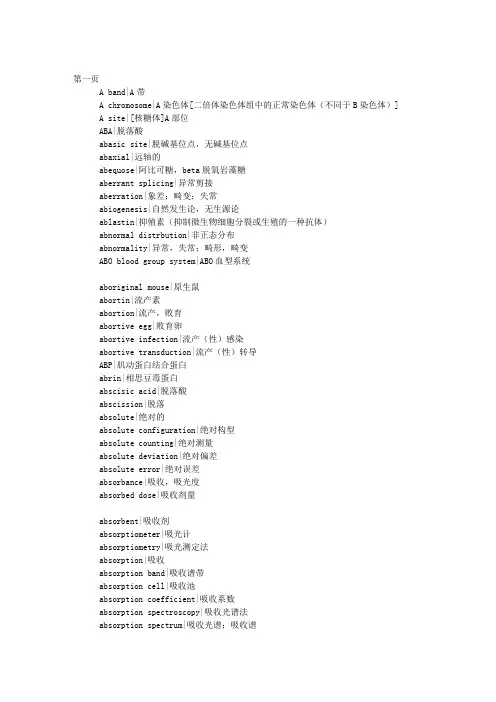
第一页A band|A带A chromosome|A染色体[二倍体染色体组中的正常染色体(不同于B染色体)] A site|[核糖体]A部位ABA|脱落酸abasic site|脱碱基位点,无碱基位点abaxial|远轴的abequose|阿比可糖,beta脱氧岩藻糖aberrant splicing|异常剪接aberration|象差;畸变;失常abiogenesis|自然发生论,无生源论ablastin|抑殖素(抑制微生物细胞分裂或生殖的一种抗体)abnormal distrbution|非正态分布abnormality|异常,失常;畸形,畸变ABO blood group system|ABO血型系统aboriginal mouse|原生鼠abortin|流产素abortion|流产,败育abortive egg|败育卵abortive infection|流产(性)感染abortive transduction|流产(性)转导ABP|肌动蛋白结合蛋白abrin|相思豆毒蛋白abscisic acid|脱落酸abscission|脱落absolute|绝对的absolute configuration|绝对构型absolute counting|绝对测量absolute deviation|绝对偏差absolute error|绝对误差absorbance|吸收,吸光度absorbed dose|吸收剂量absorbent|吸收剂absorptiometer|吸光计absorptiometry|吸光测定法absorption|吸收absorption band|吸收谱带absorption cell|吸收池absorption coefficient|吸收系数absorption spectroscopy|吸收光谱法absorption spectrum|吸收光谱;吸收谱absorptive endocytosis|吸收(型)胞吞(作用) absorptive pinocytosis|吸收(型)胞饮(作用) absorptivity|吸光系数;吸收性abundance|丰度abundant|丰富的,高丰度的abundant mRNAs|高丰度mRNAabzyme|抗体酶acaricidin|杀螨剂accedent variation|偶然变异accelerated flow method|加速流动法accepting arm|[tRNA的]接纳臂acceptor|接纳体,(接)受体acceptor site|接纳位点,接受位点acceptor splicing site|剪接受体acceptor stem|[tRNA的]接纳茎accessible|可及的accessible promoter|可及启动子accessible surface|可及表面accessory|零件,附件;辅助的accessory cell|佐细胞accessory chromosome|副染色体accessory factor|辅助因子accessory nucleus|副核accessory pigment|辅助色素accessory protein|辅助蛋白(质)accommodation|顺应accumulation|积累,累积accuracy|准确度acenaphthene|二氢苊acene|并苯acentric|无着丝粒的acentric fragment|无着丝粒断片acentric ring|无着丝粒环acetal|缩醛acetaldehyde|乙醛acetalresin|缩醛树脂acetamidase|乙酰胺酶acetamide|乙酰胺acetate|乙酸盐acetic acid|乙酸,醋酸acetic acid bacteria|乙酸菌,醋酸菌acetic anhydride|乙酸酐acetification|乙酸化作用,醋化作用acetin|乙酸甘油酯,三乙酰甘油酯acetoacetic acid|乙酰乙酸Acetobacter|醋杆菌属acetogen|产乙酸菌acetogenic bacteria|产乙酸菌acetome body|酮体acetome powder|丙酮制粉[在-30度以下加丙酮制成的蛋白质匀浆物] acetomitrile|乙腈acetone|丙酮acetyl|乙酰基acetyl coenzyme A|乙酰辅酶Aacetylcholine|乙酰胆碱acetylcholine agonist|乙酰胆碱拮抗剂acetylcholine receptor|乙酰胆碱受体acetylcholinesterase|乙酰胆碱酯酶acetylene|乙炔acetylene reduction test|乙炔还原试验[检查生物体的固氮能力] acetylglucosaminidase|乙酰葡糖胺糖苷酶acetylglutamate synthetase|乙酰谷氨酸合成酶acetylsalicylate|乙酰水杨酸;乙酰水杨酸盐、酯、根acetylsalicylic acid|乙酰水杨酸acetylspiramycin|乙酰螺旋霉素AchE|乙酰胆碱酯酶achiral|非手性的acholeplasma|无胆甾原体AchR|乙酰胆碱受体achromatic|消色的;消色差的achromatic color|无色achromatic lens|消色差透镜achromatin|非染色质acid catalysis|酸催化acid fibroblast growth factor|酸性成纤维细胞生长因子acid fuchsin|酸性品红acid glycoprotein|酸性糖蛋白acid hydrolyzed casein|酸水解酪蛋白acid medium|酸性培养基acid mucopolysaccharide|酸性粘多糖acid phosphatase|酸性磷酸酶acid protease|酸性蛋白酶acid solvent|酸性溶剂acidic|酸性的acidic amino acid|酸性氨基酸acidic protein|酸性蛋白质[有时特指非组蛋白]acidic transactivator|酸性反式激活蛋白acidic transcription activator|酸性转录激活蛋白 acidification|酸化(作用)acidifying|酸化(作用)acidolysis|酸解acidophilia|嗜酸性acidophilic bacteria|嗜酸菌acidophilous milk|酸奶aclacinomycin|阿克拉霉素acoelomata|无体腔动物acomitic acid|乌头酸aconitase|顺乌头酸酶aconitate|乌头酸;乌头酸盐、酯、根aconitine|乌头碱aconitum alkaloid|乌头属生物碱ACP|酰基载体蛋白acquired character|获得性状acquired immunity|获得性免疫acridine|吖啶acridine alkaloid|吖啶(类)生物碱acridine dye|吖啶燃料acridine orange|吖啶橙acridine yellow|吖啶黄acriflavine|吖啶黄素acroblast|原顶体acrocentric chromosome|近端着丝染色体acrolein|丙烯醛acrolein polymer|丙烯醛类聚合物acrolein resin|丙烯醛树脂acropetal translocation|向顶运输acrosin|顶体蛋白acrosomal protease|顶体蛋白酶acrosomal reaction|顶体反应acrosome|顶体acrosome reaction|顶体反应acrosomic granule|原顶体acrosyndesis|端部联会acrylamide|丙烯酰胺acrylate|丙烯酸酯、盐acrylic acid|丙烯酸acrylic polymer|丙烯酸(酯)类聚合物acrylic resin|丙烯酸(酯)类树脂acrylketone|丙烯酮acrylonitrile|丙烯腈actidione|放线(菌)酮[即环己酰亚胺]actin|肌动蛋白actin filament|肌动蛋白丝actinin|辅肌动蛋白[分为alfa、beta两种,beta蛋白即加帽蛋白] actinmicrofilament|肌动蛋白微丝actinometer|化学光度计actinomorphy|辐射对称[用于描述植物的花]actinomycetes|放线菌actinomycin D|放线菌素Dactinospectacin|放线壮观素,壮观霉素,奇霉素action|作用action current|动作电流action potential|动作电位action spectrum|动作光谱activated sludge|活性污泥activated support|活化支持体activating group|活化基团activating transcription factor|转录激活因子activation|激活;活化activation analysis|活化分析activation energy|活化能activator|激活物,激活剂,激活蛋白activator protein|激活蛋白active absorption|主动吸收active biomass|活生物质active carbon|活性碳active center|活性中心active chromatin|活性染色质active dry yeast|活性干酵母active dydrogen compounds|活性氢化合物active ester of amino acid|氨基酸的活化酯active hydrogen|活性氢active immunity|主动免疫active oxygen|活性氧active site|活性部位,活性中心active transport|主动转运active uptake|主动吸收activin|活化素[由垂体合成并由睾丸和卵巢分泌的性激素]activity|活性,活度,(放射性)活度actomyosin|肌动球蛋白actophorin|载肌动蛋白[一种肌动蛋白结合蛋白]acute|急性的acute infection|急性感染acute phase|急性期acute phase protein|急性期蛋白,急相蛋白acute phase reaction|急性期反应,急相反应[炎症反应急性期机体的防御反应] acute phase reactive protein|急性期反应蛋白,急相反应蛋白acute phase response|急性期反应,急相反应acute toxicity|急性毒性ACV|无环鸟苷acyclic nucleotide|无环核苷酸acycloguanosine|无环鸟苷,9-(2-羟乙氧甲基)鸟嘌呤acyclovir|无环鸟苷acyl|酰基acyl carrier protein|酰基载体蛋白acyl cation|酰(基)正离子acyl chloride|酰氯acyl CoA|脂酰辅酶Aacyl coenzyem A|脂酰辅酶Aacyl fluoride|酰氟acyl halide|酰卤acylamino acid|酰基氨基酸acylase|酰基转移酶acylating agent|酰化剂acylation|酰化acylazide|酰叠氮acylbromide|酰溴acyloin|偶姻acyltransferase|酰基转移酶adamantanamine|金刚烷胺[曾用作抗病毒剂]adamantane|金刚烷adaptability|适应性adaptation|适应adapter|衔接头;衔接子adapter protein|衔接蛋白质adaptin|衔接蛋白[衔接网格蛋白与其他蛋白的胞质区]adaptive behavior|适应性行为adaptive enzyme|适应酶adaptive molecule|衔接分子adaptive response|适应反应[大肠杆菌中的DNA修复系统]adaptor|衔接头;衔接子adaxial|近轴的addition|加成addition compound|加成化合物addition haploid|附加单倍体addition line|附加系additive|添加物,添加剂additive effect|加性效应additive genetic variance|加性遗传方差additive recombination|插入重组,加插重组[因DNA插入而引起的基因重组] addressin|地址素[选择蛋白(selectin)的寡糖配体,与淋巴细胞归巢有关]adducin|内收蛋白[一种细胞膜骨架蛋白,可与钙调蛋白结合]adduct|加合物,加成化合物adduct ion|加合离子adenine|腺嘌呤adenine arabinoside|啊糖腺苷adenine phosphoribosyltransferase|腺嘌呤磷酸核糖转移酶adenoma|腺瘤adenosine|腺嘌呤核苷,腺苷adenosine deaminase|腺苷脱氨酶adenosine diphoshate|腺苷二磷酸adenosine monophosphate|腺苷(一磷)酸adenosine phosphosulfate|腺苷酰硫酸adenosine triphosphatase|腺苷三磷酸酶adenosine triphosphate|腺苷三磷酸adenovirus|腺病毒adenylate|腺苷酸;腺苷酸盐、酯、根adenylate cyclase|腺苷酸环化酶adenylate energy charge|腺苷酸能荷adenylate kinase|腺苷酸激酶adenylic acid|腺苷酸adenylyl cyclase|腺苷酸环化酶adenylylation|腺苷酰化adherence|粘着,粘附,粘连;贴壁adherent cell|贴壁赴 徽匙牛ㄐ裕┫赴 掣剑ㄐ裕┫赴?/P>adherent culture|贴壁培养adhering junction|粘着连接adhesin|粘附素[如见于大肠杆菌]adhesion|吸附,结合,粘合;粘着,粘附,粘连adhesion factor|粘着因子,粘附因子adhesion molecule|粘着分子,粘附分子adhesion plaque|粘着斑adhesion protein|粘着蛋白,吸附蛋白adhesion receptor|粘着受体adhesion zone|粘着带[如见于细菌壁膜之间]adhesive|粘合剂,胶粘剂adhesive glycoprotein|粘着糖蛋白adipic acid|己二酸,肥酸adipocyte|脂肪细胞adipokinetic hormone|脂动激素[见于昆虫]adipose tissue|脂肪组织adjust|[动]调节,调整;修正adjustable|可调的adjustable miropipettor|可调微量移液管adjustable spanner|活动扳手adjusted retention time|调整保留时间adjusted retention volume|调整保留体积adjuvant|佐剂adjuvant cytokine|佐剂细胞因子adjuvant peptide|佐剂肽adjuvanticity|佐剂(活)性adoptive immunity|过继免疫adoptive transfer|过继转移ADP ribosylation|ADP核糖基化ADP ribosylation factor|ADP核糖基化因子ADP ribosyltransferase|ADP核糖基转移酶adrenal cortical hormone|肾上腺皮质(激)素adrenaline|肾上腺素adrenergic receptor|肾上腺素能受体adrenocepter|肾上腺素受体adrenocorticotropic hormone|促肾上腺皮质(激)素adrenodoxin|肾上腺皮质铁氧还蛋白adriamycin|阿霉素,亚德里亚霉素adsorbent|吸附剂adsorption|吸附adsorption catalysis|吸附催化adsorption center|吸附中心adsorption chromatography|吸附层析adsorption film|吸附膜adsorption isobar|吸附等压线adsorption isotherm|吸附等温线adsorption layer|吸附层adsorption potential|吸附电势adsorption precipitation|吸附沉淀adsorption quantity|吸附量adult diarrhea rotavirus|成人腹泻轮状病毒advanced glycosylation|高级糖基化advanced glycosylation end product|高级糖基化终产物 adventitious|不定的,无定形的adverse effect|反效果,副作用aecidiospore|锈孢子,春孢子aeciospore|锈孢子,春孢子aequorin|水母蛋白,水母素aeration|通气aerator|加气仪,加气装置aerial mycelium|气生菌丝体aerobe|需氧菌[利用分子氧进行呼吸产能并维持正常生长繁殖的细菌] aerobic|需氧的aerobic bacteria|需氧(细)菌aerobic cultivation|需氧培养aerobic glycolysis|有氧酵解aerobic metabolism|有氧代谢aerobic respiration|需氧呼吸aerobic waste treatment|需氧废物处理aerobiosis|需氧生活aerogel|气凝胶aerogen|产气菌aerolysin|气单胞菌溶素Aeromonas|气单胞菌属aerosol|气溶胶aerosol gene delivery|气溶胶基因送递aerospray ionization|气喷射离子化作用aerotaxis|趋氧性[(细胞)随环境中氧浓度梯度进行定向运动]aerotolerant bacteria|耐氧菌[不受氧毒害的厌氧菌]aerotropism|向氧性aesculin|七叶苷,七叶灵aetiology|病原学B cell|B细胞B cell antigen receptor|B细胞抗原受体B cell differentiation factor|B细胞分化因子B cell growth factor|B细胞生长因子B cell proliferation|B细胞增殖B cell receptor|B细胞受体B cell transformation|B细胞转化B chromosome|B染色体[许多生物(如玉米)所具有的异染质染色体] B to Z transition|B-Z转换[B型DNA向Z型DNA转换]Bacillariophyta|硅藻门Bacillus|芽胞杆菌属Bacillus anthracis|炭疽杆菌属Bacillus subtillis|枯草芽胞杆菌bacitracin|杆菌肽back donation|反馈作用back flushing|反吹,反冲洗back mutation|回复突变[突变基因又突变为原由状态]backbone|主链;骨架backbone hydrogen bond|主链氢键backbone wire model|主链金属丝模型[主要反应主链走向的实体模型]backcross|回交backflushing chromatography|反吹层析,反冲层析background|背景,本底background absorption|背景吸收background absorption correction|背景吸收校正background correction|背景校正background gactor|背景因子background genotype|背景基因型[与所研究的表型直接相关的基因以外的全部基因]background hybridization|背景杂交background radiation|背景辐射,本底辐射backmixing|反向混合backside attack|背面进攻backward reaction|逆向反应backwashing|反洗bacmid|杆粒[带有杆状病毒基因组的质粒,可在细菌和昆虫细胞之间穿梭]bacteremia|菌血症bacteria|(复)细菌bacteria rhodopsin|细菌视紫红质bacterial adhesion|细菌粘附bacterial alkaline phosphatase|细菌碱性磷酸酶bacterial artificial chromosome|细菌人工染色体bacterial colony|(细菌)菌落bacterial colony counter|菌落计数器bacterial conjugation|细菌接合bacterial filter|滤菌器bacterial invasion|细菌浸染bacterial motility|细菌运动性bacterial rgodopsin|细菌视紫红质,细菌紫膜质bacterial vaccine|菌苗bacterial virulence|细菌毒力bactericidal reaction|杀(细)菌反应bactericide|杀(细)菌剂bactericidin|杀(细)菌素bactericin|杀(细)菌素bacteriochlorophyll|细菌叶绿素bacteriochlorophyll protein|细菌叶绿素蛋白bacteriocide|杀(细)菌剂bacteriocin|细菌素bacteriocin typing|细菌素分型[利用细菌素对细胞进行分型]bacterioerythrin|菌红素bacteriofluorescein|细菌荧光素bacteriology|细菌学bacteriolysin|溶菌素bacteriolysis|溶菌(作用)bacteriolytic reaction|溶菌反应bacteriophaeophytin|细菌叶褐素bacteriophage|噬菌体bacteriophage arm|噬菌体臂bacteriophage conversion|噬菌体转变bacteriophage head|噬菌体头部bacteriophage surface expression system|噬菌体表面表达系统bacteriophage tail|噬菌体尾部bacteriophage typing|噬菌体分型bacteriophagology|噬菌体学bacteriopurpurin|菌紫素bacteriorhodopsin|细菌视紫红质bacteriosome|细菌小体[昆虫体内一种含有细菌的结构]bacteriostasis|抑菌(作用)bacteriostat|抑菌剂bacteriotoxin|细菌毒素bacteriotropin|亲菌素bacterium|细菌bacteroid|类菌体baculovirus|杆状病毒bag sealer|封边机baking soda|小苏打BAL 31 nuclease|BAL 31核酸酶balance|天平balanced heterokaryon|平衡异核体balanced lethal|平衡致死balanced lethal gene|平衡致死基因balanced linkage|平衡连锁balanced pathogenicity|平衡致病性balanced polymorphism|平衡多态性balanced salt solution|平衡盐溶液balanced solution|平衡溶液balanced translocation|平衡易位balbaini ring|巴尔比亚尼环[由于RNA大量合成而显示特别膨大的胀泡,在多线染色体中形成独特的环]Balbiani chromosome|巴尔比亚尼染色体[具有染色带的多线染色体,1881年首先发现于双翅目摇蚊幼虫]ball mill|球磨ball mill pulverizer|球磨粉碎机ball milling|球磨研磨balloon catheter|气囊导管[可用于基因送递,如将DNA导入血管壁]banana bond|香蕉键band|条带,带[见于电泳、离心等]band broadening|条带加宽band sharpening|条带变细,条带锐化band width|带宽banding pattern|带型banding technique|显带技术,分带技术barbiturate|巴比妥酸盐barium|钡barly strip mosaic virus|大麦条纹花叶病毒barly yellow dwarf virus|大麦黄矮病毒barnase|芽胞杆菌RNA酶[见于解淀粉芽胞杆菌]barophilic baceria|嗜压菌baroreceptor|压力感受器barotaxis|趋压性barotropism|向压性barr body|巴氏小体barrel|桶,圆筒[可用于描述蛋白质立体结构,如beta折叠桶]barrier|屏障,垒barstar|芽胞杆菌RNA酶抑制剂[见于解淀粉芽胞杆菌]basal|基础的,基本的basal body|基粒basal body temperature|基础体温basal component|基本成分,基本组分basal expression|基础表达,基态表达basal granule|基粒basal heat producing rate|基础产热率basal lamina|基膜,基板basal level|基础水平,基态水平basal medium|基本培养基,基础培养基basal medium Eagle|Eagle基本培养基basal metabolic rate|基础代谢率basal metabolism|基础代谢basal promoter element|启动子基本元件basal transcription|基础转录,基态转录basal transcription factor|基础转录因子base|碱基;碱base analog|碱基类似物,类碱基base catalysis|碱基催化base composition|碱基组成base pairing|碱基配对base pairing rules|碱基配对法则,碱基配对规则base peak|基峰base pire|碱基对base ratio|碱基比base stacking|碱基堆积base substitution|碱基置换baseline|基线baseline drift|基线漂移baseline noise|基线噪声basement membrane|基底膜basement membrane link protein|基底膜连接蛋白basic amino acid|碱性氨基酸basic fibroblast growth factor|碱性成纤维细胞生长因子basic fuchsin|碱性品红basic medium|基础培养基basic number of chromosome|染色体基数basic protein|碱性蛋白质basic solvent|碱性溶剂basic taste sensation|基本味觉basidiocarp|担子果basidiomycetes|担子菌basidium|担子basipetal translocation|向基运输basket centrifuge|(吊)篮式离心机basket drier|篮式干燥机basket type evaporator|篮式蒸发器basonuclin|碱(性)核蛋白[见于角质形成细胞,含有多对锌指结构] basophil|嗜碱性细胞basophil degranulation|嗜碱性细胞脱粒basophilia|嗜碱性batch|分批;批,一批batch cultivation|分批培养batch culture|分批培养物batch digestor|分批消化器batch extraction|分批抽提,分批提取batch fermentation|分批发酵,(罐)批发酵batch filtration|分批过滤batch operation|分批操作batch process|分批工艺,分批法batch reactor|间歇反应器,分批反应器batch recycle cultivation|分批再循环培养batch recycle culture|分批再循环培养(物)bathochrome|向红基bathochromic shift|红移bathorhodopsin|红光视紫红质,前光视紫红质batrachotoxin|树蛙毒素[固醇类生物碱,作用于钠通道] baytex|倍硫磷BCG vaccine|卡介苗bead mill|玻珠研磨机bead mill homogenizer|玻珠研磨匀浆机bean sprouts medium|豆芽汁培养基beauvericin|白僵菌素becquerel|贝可(勒尔)bed volume|(柱)床体积bee venom|蜂毒beef broth|牛肉汁beef extract|牛肉膏,牛肉提取物beet yellows virus|甜菜黄化病毒Beggiatoa|贝日阿托菌属[属于硫细菌]behavior|行为;性质,性能behavioral control|行为控制behavioral isolation|行为隔离behavioral thermoregulation|行为性体温调节behenic acid|山yu酸,二十二(烷)酸belt desmosome|带状桥粒belt press|压带机belt press filter|压带(式)滤器bench scale|桌面规模,小试规模benchtop bioprocessing|桌面生物工艺[小试规模]benchtop microcentrifuge|台式微量离心机bend|弯曲;弯管;转折bending|弯曲;转折,回折beneficial element|有益元素bent bond|弯键bent DNA|弯曲DNA,转折DNAbenzene|苯benzhydrylamine resin|二苯甲基胺树脂benzidine|联苯胺benzilate|三苯乙醇酸(或盐或酯)benzimidazole|苯并咪唑benzodiazine|苯并二嗪,酞嗪benzoin|苯偶姻,安息香benzophenanthrene|苯并菲benzopyrene|苯并芘benzoyl|苯甲酰基benzoylglycine|苯甲酰甘氨酸benzyl|苄基benzyladenine|苄基腺嘌呤benzylaminopurine|苄基氨基嘌呤benzylisoquinoline|苄基异喹啉benzylisoquinoline alkaloid|苄基异喹啉(类)生物碱benzylpenicillin|苄基青霉素berberine|小檗碱Bertrand rule|贝特朗法则bestatin|苯丁抑制素[可抑制亮氨酸氨肽酶的一种亮氨酸类似物]C value|C值[单倍基因组DNA的量]C value paradox|C值悖理[物种的C值和它的进化复杂性之间无严格对应关系]C4 dicarboxylic acid cycle|C4二羧酸循环cachectin|恶液质素[即alfa肿瘤坏死因子]cadaverine|尸胺cadherin|钙粘着蛋白[介导依赖(于)钙的细胞间粘着作用的一类跨膜蛋白质,分为E-,N-,P-等若干种,E表示上皮(epithelia),N表示神经(neural),P表示胎盘(placental)] cadmium|镉caerulin|雨蛙肽cage|笼cage compound|笼形化合物cage coordination compound|笼形配合物cage effect|笼效应cage structure|笼形结构[非极性分子周围的水分子所形成的有序结构]calbindin|钙结合蛋白calciferol|麦角钙化(固)醇calcimedin|钙介蛋白[钙调蛋白拮抗剂]calcineurin|钙调磷酸酶[依赖于钙调蛋白的丝氨酸—苏氨酸磷酸酶]calcionin|降钙素calcium binding protein|钙结合蛋白(质)calcium binding site|钙结合部位calcium channel|钙通道calcium chloride|氯化钙calcium influx|钙流入calcium mediatory protein|钙中介蛋白(质)calcium phosphate|磷酸钙calcium phosphate precipitation|磷酸盐沉淀calcium pump|钙泵calcium sensor protein|钙传感蛋白(质)calcium sequestration|集钙(作用)calcyclin|钙(细胞)周边蛋白calcyphosine|钙磷蛋白[是依赖于cAMP的蛋白激酶的磷酸化底物]caldesmon|钙调(蛋白)结合蛋白[主要见于平滑肌,可与钙调蛋白及肌动蛋白结合] calelectrin|钙电蛋白[最初发现于鳗鱼电器官的一种钙结合蛋白]calf intestinal alkaline phosphatase|(小)牛小肠碱性磷酸酶calf serum|小牛血清calf thymus|小牛胸腺calgranulin|钙粒蛋白calibration|校准,标准calibration curve|校正曲线calibration filter|校准滤光片calibration protein|校准蛋白calicheamycin|刺孢霉素[来自刺孢小单胞菌的抗肿瘤抗生素,带有二炔烯官能团] calicivirus|杯状病毒calli|(复)胼胝体,愈伤组织[用于植物];胼胝[见于动物皮肤]callose|胼胝质,愈伤葡聚糖callose synthetase|愈伤葡聚糖合成酶callus|胼胝体,愈伤组织[用于植物];胼胝[见于动物皮肤]callus culture|愈伤组织培养calmodulin|钙调蛋白calnexin|钙联结蛋白[内质网的一种磷酸化的钙结合蛋白]calomel|甘汞calomel electrode|甘汞电极calorie|卡calpactin|依钙(结合)蛋白[全称为“依赖于钙的磷脂及肌动蛋白结合蛋白”]calpain|(需)钙蛋白酶calpain inhibitor|(需)钙蛋白酶抑制剂calpastatin|(需)钙蛋白酶抑制蛋白calphobindin|钙磷脂结合蛋白calphotin|钙感光蛋白[感光细胞的一种钙结合蛋白]calprotectin|(肌)钙网蛋白[骨骼肌肌质网膜上的钙结合蛋白]calretinin|钙(视)网膜蛋白calsequestrin|(肌)集钙蛋白calspectin|钙影蛋白calspermin|钙精蛋白[睾丸的一种钙调蛋白结合蛋白]caltractin|钙牵蛋白[一种与基粒相关的钙结合蛋白]Calvin cycle|卡尔文循环,光合碳还原环calyculin|花萼海绵诱癌素[取自花萼盘皮海绵的磷酸酶抑制剂]calyptra|根冠calyx|花萼cambium|形成层[见于植物]cAMP binding protein|cAMP结合蛋白cAMP receptor protein|cAMP受体蛋白cAMP response element|cAMP效应元件cAMP response element binding protein|cAMP效应元件结合蛋白Campbell model|坎贝尔模型camphane|莰烷camphane derivative|莰烷衍生物camphore|樟脑camptothecin|喜树碱Campylobacter|弯曲菌属Campylobacter fetus|胎儿弯曲菌属Canada balsam|加拿大香脂,枞香脂canaline|副刀豆氨酸canalization|[表型]限渠道化,发育稳态[尽管有遗传因素和环境条件的干扰,表型仍保持正常]canavanine|刀豆氨酸cancer|癌症cancer metastasis|癌症转移cancer suppressor gene|抑癌基因cancer suppressor protein|抑癌基因产物,抑癌蛋白(质)candicidin|杀假丝菌素candida|念珠菌属Candida albicans|白色念珠菌candle jar|烛罐cannabin|大麻苷;大麻碱canonical base|规范碱基canonical molecular orbital|正则分子轨道canonical partition function|正则配分函数canonical sequence|规范序列cantharidin|斑蝥素canthaxanthin|角黄素canyon|峡谷[常用于比喻某些生物大分子的主体结构特征]cap|帽,帽(结构)cap binding protein|帽结合蛋白cap site|加帽位点capacitation|获能[特指镜子在雌性生殖道中停留后获得使卵子受精的能力]capacity|容量capacity factor|容量因子capillarity|毛细现象capillary|毛细管;毛细血管capillary absorption|毛细吸收capillary action|毛细管作用capillary attraction|毛细吸力capillary column|毛细管柱capillary culture|毛细管培养capillary electrode|毛细管电极capillary electrophoresis|毛细管电泳capillary free electrophoresis|毛细管自由流动电泳capillary gas chromatography|毛细管气相层析capillary isoelectric focusing|毛细管等电聚焦capillary isotachophoresis|毛细管等速电泳capillary membrane module|毛细管膜包capillary transfer|毛细管转移[通过毛细管作用进行核酸的印迹转移] capillary tube|毛细管capillary tubing|毛细管capillary zone electrophoresis|毛细管区带电泳capillovirus|毛状病毒组capping|加帽,加帽反应;封闭反应;帽化,成帽capping enzyme|加帽酶capping protein|[肌动蛋白]加帽蛋白caprin|癸酸甘油酯caproin|己酸甘油酯capromycin|卷曲霉素,缠霉素caproyl|己酸基caprylin|辛酸甘油酯capsid|(病毒)衣壳,(病毒)壳体capsid protein|衣壳蛋白capsidation|衣壳化capsomer|(病毒)壳粒capsular polysaccharide|荚膜多糖capsulation|包囊化(作用),胶囊化(作用)capsule|荚膜capsule swelling reaction|荚膜肿胀反应capture|捕捉,俘获capture antigen|捕捉抗原[酶免疫测定中用于捕捉抗体的抗原]capture assay|捕捉试验carbamyl|氨甲酰基carbamyl ornithine|氨甲酰鸟氨酸carbamyl phosphate|氨甲酰磷酸carbamyl phosphate synthetase|氨甲酰磷酸合成酶carbamyl transferase|氨甲酰(基)转移酶carbamylation|氨甲酰化carbanion|碳负离子carbanyl group|羰基carbene|卡宾carbenicillin|羧苄青霉素carbenoid|卡宾体carbocation|碳正离子carbodiimide|碳二亚胺carbohydrate|糖类,碳水化合物carbohydrate fingerprinting|糖指纹分析carbohydrate mapping|糖作图,糖定位carbohydrate sequencing|糖测序carbol fuchsin|石炭酸品红carboline|咔啉,二氮芴carbon assimilation|碳同化carbon balance|碳平衡carbon cycling|碳循环carbon dioxide|二氧化碳carbon dioxide compensation|二氧化碳补偿点carbon dioxide fertilization|二氧化碳施肥carbon dioxide fixation|二氧化碳固定carbon dioxide tension|二氧化碳张力carbon fiber|碳纤维carbon fixation|碳固定carbon isotope|碳同位素carbon isotope analysis|碳同位素分析carbon isotope composition|碳同位素组成carbon monoxide|一氧化碳carbon source|碳源carbonate|碳酸盐,碳酸酯carbonate plant|碳化植物carbonic anhydrase|碳酸酐酶carbonium ion|碳正离子carbonyl|羰基carbonylation|羰基化carboxydismutase|羰基岐化酶,核酮糖二磷酸羧化酶 carboxydotrophic bacteria|一氧化碳营养菌carboxyglutamic acid|羧基谷氨酸carboxyl|羧基carboxyl protease|羧基蛋白酶carboxyl terminal|羧基端carboxyl transferase|羧基转移酶carboxylase|羧化酶carboxylation|羧(基)化carboxylic acid|羧酶carboxymethyl|羧甲基carboxymethyl cellulose|羧甲基纤维素carboxypeptidase|羧肽酶[包括羧肽酶A、B、N等]carcinogen|致癌剂carcinogenesis|致癌,癌的发生carcinogenicity|致癌性carcinoma|癌carcinostatin|制癌菌素cardenolide|强心苷cardiac aglycone|强心苷配基,强心苷元cardiac cycle|心动周期cardiac glycoside|强心苷cardiac receptor|心脏感受器cardiohepatid toxin|心肝毒素[如来自链球菌]cardiolipin|心磷脂cardiotoxin|心脏毒素cardiovascular center|心血管中枢cardiovascular disease|心血管疾病cardiovirus|心病毒属[模式成员是脑心肌炎病毒]carlavirus|香石竹潜病毒组carmine|洋红carminomycin|洋红霉素carmovirus|香石竹斑驳病毒组carnation latent virus|香石竹潜病毒carnation mottle virus|香石竹斑驳病毒carnation ringspot virus|香石竹环斑病毒carnitine|肉碱carnitine acyl transferase|肉碱脂酰转移酶carnosine|肌肽[即beta丙氨酰组氨酸]carotene|胡萝卜素carotene dioxygenase|胡萝卜素双加氧酶carotenoid|类胡萝卜素carotenoprotein|胡萝卜素蛋白carpel|[植物]心皮carrageen|角叉菜,鹿角菜carrageenin|角叉菜胶carrier|载体,运载体,携载体;携带者,带(病)毒者,带菌者 carrier ampholyte|载体两性电解质carrier catalysis|载体催化carrier coprecipitation|载体共沉淀carrier DNA|载体DNAcarrier free|无载体的carrier phage|载体噬菌体carrier precipitation|载体沉淀(作用)carrier state|携带状态carriomycin|腐霉素,开乐霉素cartridge|[萃取柱的]柱体;软片,胶卷;子弹,弹药筒casamino acid|(水解)酪蛋白氨基酸,酪蛋白水解物cascade|串联,级联,级联系统cascade amplification|级联放大cascade chromatography|级联层析cascade fermentation|级联发酵casein|酪蛋白,酪素casein kinase|酪蛋白激酶[分I、II两种]Casparian band|凯氏带[见于植物内表皮细胞]Casparian strip|凯氏带cassette|盒,弹夹[借指DNA序列组件]cassette mutagenesis|盒式诱变casting|铸,灌制CAT box|CAT框[真核生物结构基因上游的顺式作用元件]catabolism|分解代谢catabolite gene activator protein|分解代谢物基因激活蛋白 catabolite repression|分解代谢物阻抑,分解代谢产物阻遏catalase|过氧化氢酶catalytic active site|催化活性位catalytic activity|催化活性catalytic antibody|催化性抗体,具有催化活性的抗体catalytic constant|催化常数[符号Kcat]catalytic core|催化核心catalytic mechanism|催化机理catalytic RNA|催化性RNAcatalytic selectivity|催化选择性catalytic site|催化部位catalytic subunit|催化亚基cataphoresis|阳离子电泳cataract|白内障catechin|儿茶素catechol|儿茶酚,邻苯二酚catecholamine|儿茶酚胺catecholamine hormones|儿茶酚胺类激素catecholaminergic recptor|儿茶酚胺能受体catenane|连环(体),连锁,链条[如DNA连环体];索烃catenating|连环,连接catenation|连环,连锁,成链catenin|连环蛋白[一类细胞骨架蛋白,分alfa/beta/gama三种] catharanthus alkaloid|长春花属生物碱cathepsin|组织蛋白酶[分为A、B、C、D、E…H、L等多种]catheter|导管cathode layer enrichment method|阴极区富集法cathode ray polarograph|阴极射线极谱仪cation acid|阳离子酸cationic acid|阳离子酸cationic catalyst|正离子催化剂cationic detergent|阳离子(型)去污剂cationic initiator|正离子引发剂cationic polymerization|正离子聚合,阳离子聚合 cationic surfactant|阳离子(型)表面活性剂cationization|阳离子化cauliflower mosaic virus|花椰菜花叶病毒caulimovirus|花椰菜花叶病毒组caulobacteria|柄病毒Cavendish laboratory|(英国)卡文迪什实验室caveola|小窝,小凹caveolae|(复)小窝,小凹caveolin|小窝蛋白cavitation|空腔化(作用)cavity|沟槽,模槽,空腔dammarane|达玛烷dammarane type|达玛烷型Dane particle|丹氏粒[乙型肝炎病毒的完整毒粒]dansyl|丹(磺)酰,1-二甲氨基萘-5-磺酰dansyl chloride|丹磺酰氯dansyl method|丹磺酰法dantrolene|硝苯呋海因[肌肉松弛剂]dark current|暗电流dark field|暗视野,暗视场dark field microscope|暗视野显微镜,暗视场显微镜 dark field microscopy|暗视野显微术,暗视场显微术 dark reaction|暗反应dark repair|暗修复dark respiration|暗呼吸dark room|暗室,暗房dark seed|需暗种子data accumulation|数据积累data acquisition|数据获取data analysis|数据分析data bank|数据库data base|数据库data handling|数据处理data logger|数据记录器data logging|数据记录data output|数据输出data processing|数据处理data recording|数据记录dauermodification|持续饰变daughter cell|子代细胞daughter chromatid|子染色单体daughter chromosome|子染色体daughter colony|子菌落[由原生菌落续发生长的小菌落]daunomycin|道诺霉素daunorubicin|道诺红菌素de novo sequencing|从头测序de novo synthesis|从头合成deactivation|去活化(作用),失活(作用),钝化deacylated tRNA|脱酰tRNAdead time|死时间dead volume|死体积deadenylation|脱腺苷化DEAE Sephacel|[商]DEAE-葡聚糖纤维素,二乙氨乙基葡聚糖纤维素 dealkylation|脱烷基化deaminase|脱氨酶deamination|脱氨(基)death phase|死亡期[如见于细胞生长曲线]death point|死点deblocking|去封闭debranching enzyme|脱支酶,支链淀粉酶debris|碎片,残渣decahedron|十面体decane|癸烷decantation|倾析decanting|倾析decapacitation|去(获)能decarboxylase|脱羧酶decarboxylation|脱羧(作用)decay|原因不明腐败decay accelerating factor|衰变加速因子decay constant|衰变常数deceleration phase|减速期[如见于细胞生长曲线]dechlorination|脱氯作用deciduous leaf|落叶decline phase|[细胞生长曲线的]衰亡期decoagulant|抗凝剂decoding|译码,解码decomposer|分解者[可指具有分解动植物残体或其排泄物能力的微生物] decompression|降压,减压decondensation|解凝(聚)decontaminant|净化剂,去污剂decontaminating agent|净化剂,去污剂decontamination|净化,去污decorin|核心蛋白聚糖[一种基质蛋白聚糖,又称为PG-40]dedifferentiation|去分化,脱分化deep colony|深层菌落deep etching|深度蚀刻deep jet fermentor|深部喷注发酵罐deep refrigeration|深度冷冻deep shaft system|深井系统[如用于污水处理]defasciculation factor|解束因子[取自水蛭,可破坏神经束]defective|缺损的,缺陷的defective interfering|缺损干扰defective interfering particle|缺损干扰颗粒,干扰缺损颗粒defective interfering RNA|缺损干扰RNAdefective interfering virus|缺损干扰病毒defective mutant|缺损突变体,缺陷突变型,缺陷突变株defective phage|缺损噬菌体,缺陷噬菌体defective virus|缺损病毒,缺陷病毒defense|防御,防卫defense peptide|防卫肽defense response|防御反应,防卫反应defensin|防卫素[动物细胞的内源性抗菌肽]deficiency|缺乏,缺损,缺陷deficient|缺少的,缺损的,缺陷的defined|确定的defined medium|确定成分培养基,已知成分培养液defintion|定义defoliating agent|脱叶剂defoliation|脱叶deformylase|去甲酰酶[见于原核细胞,作用于甲酰甲硫氨酸]degasser|脱气装置degassing|脱气,除气degeneracy|简并;简并性,简并度degenerate|简并的degenerate codon|简并密码子degenerate oligonucleotide|简并寡核苷酸degenerate primer|简并引物degenerate sequence|简并序列degeneration|退化,变性degenerin|退化蛋白[与某些感觉神经元的退化有关]deglycosylation|去糖基化degradable polymer|降解性高分子degradation|降解degranulation|脱(颗)粒(作用)degree of acidity|酸度degree of dominance|显性度degree of polymerization|聚合度degron|降解决定子[决定某一蛋白发生降解或部分降解的序列要素] deguelin|鱼藤素dehalogenation|脱卤(作用)dehardening|解除锻炼dehumidifier|除湿器dehydratase|脱水酶dehydrated medium|干燥培养基dehydration|脱水(作用)dehydroepiandrosterone|脱氢表雄酮dehydrogenase|脱氢酶dehydrogenation|脱氢(作用)dehydroluciferin|脱氢萤光素deionization|去离子(作用)deionized|去离子的deionized water|去离子水deionizing|去离子(处理)delayed early transcription|(延)迟早期转录[可特指病毒]delayed fluorescence|延迟荧光delayed heat|延迟热delayed hypersensitivity|延迟(型)超敏反应delayed ingeritance|延迟遗传delayed type hypersensitivity|迟发型超敏反应deletant|缺失体deletion|缺失deletion mapping|缺失定位,缺失作图deletion mutagenesis|缺失诱变deletion mutant|缺失突变体deletion mutantion|缺失突变deletional recombination|缺失重组delignification|脱木质化(作用)deliquescence|潮解delivery flask|分液瓶delocalized bond|离域键。

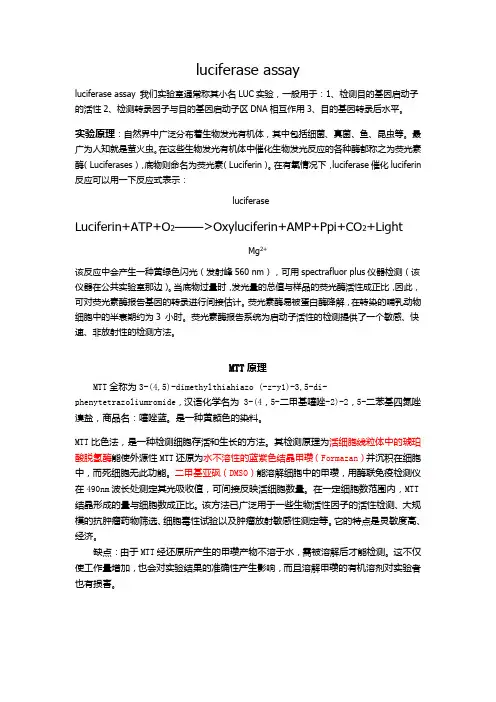
luciferase assayluciferase assay 我们实验室通常称其小名LUC实验,一般用于:1、检测目的基因启动子的活性2、检测转录因子与目的基因启动子区DNA相互作用3、目的基因转录后水平。
实验原理:自然界中广泛分布着生物发光有机体,其中包括细菌、真菌、鱼、昆虫等。
最广为人知就是萤火虫。
在这些生物发光有机体中催化生物发光反应的各种酶都称之为荧光素酶(Luciferases),底物则命名为荧光素(Luciferin)。
在有氧情况下,luciferase催化luciferin 反应可以用一下反应式表示:luciferaseLuciferin+ATP+O2——>Oxyluciferin+AMP+Ppi+CO2+LightMg2+该反应中会产生一种黄绿色闪光(发射峰560 nm),可用spectrafluor plus仪器检测(该仪器在公共实验室那边)。
当底物过量时,发光量的总值与样品的荧光酶活性成正比,因此,可对荧光素酶报告基因的转录进行间接估计。
荧光素酶易被蛋白酶降解,在转染的哺乳动物细胞中的半衰期约为3 小时。
荧光素酶报告系统为启动子活性的检测提供了一个敏感、快速、非放射性的检测方法。
MTT原理MTT全称为3-(4,5)-dimethylthiahiazo (-z-y1)-3,5-di- phenytetrazoliumromide,汉语化学名为 3-(4,5-二甲基噻唑-2)-2,5-二苯基四氮唑溴盐,商品名:噻唑蓝。
是一种黄颜色的染料。
MTT比色法,是一种检测细胞存活和生长的方法。
其检测原理为活细胞线粒体中的琥珀酸脱氢酶能使外源性MTT还原为水不溶性的蓝紫色结晶甲瓒(Formazan)并沉积在细胞中,而死细胞无此功能。
二甲基亚砜(DMSO)能溶解细胞中的甲瓒,用酶联免疫检测仪在490nm波长处测定其光吸收值,可间接反映活细胞数量。
在一定细胞数范围内,MTT 结晶形成的量与细胞数成正比。
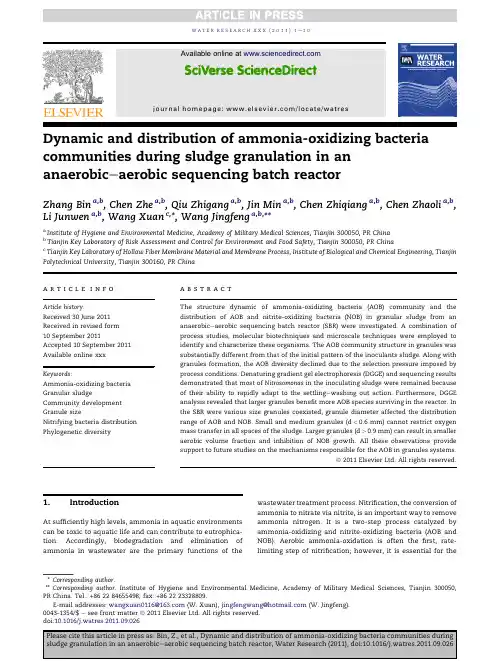
Dynamic and distribution of ammonia-oxidizing bacteria communities during sludge granulation in an anaerobic e aerobic sequencing batch reactorZhang Bin a ,b ,Chen Zhe a ,b ,Qiu Zhigang a ,b ,Jin Min a ,b ,Chen Zhiqiang a ,b ,Chen Zhaoli a ,b ,Li Junwen a ,b ,Wang Xuan c ,*,Wang Jingfeng a ,b ,**aInstitute of Hygiene and Environmental Medicine,Academy of Military Medical Sciences,Tianjin 300050,PR China bTianjin Key Laboratory of Risk Assessment and Control for Environment and Food Safety,Tianjin 300050,PR China cTianjin Key Laboratory of Hollow Fiber Membrane Material and Membrane Process,Institute of Biological and Chemical Engineering,Tianjin Polytechnical University,Tianjin 300160,PR Chinaa r t i c l e i n f oArticle history:Received 30June 2011Received in revised form 10September 2011Accepted 10September 2011Available online xxx Keywords:Ammonia-oxidizing bacteria Granular sludgeCommunity development Granule sizeNitrifying bacteria distribution Phylogenetic diversitya b s t r a c tThe structure dynamic of ammonia-oxidizing bacteria (AOB)community and the distribution of AOB and nitrite-oxidizing bacteria (NOB)in granular sludge from an anaerobic e aerobic sequencing batch reactor (SBR)were investigated.A combination of process studies,molecular biotechniques and microscale techniques were employed to identify and characterize these organisms.The AOB community structure in granules was substantially different from that of the initial pattern of the inoculants sludge.Along with granules formation,the AOB diversity declined due to the selection pressure imposed by process conditions.Denaturing gradient gel electrophoresis (DGGE)and sequencing results demonstrated that most of Nitrosomonas in the inoculating sludge were remained because of their ability to rapidly adapt to the settling e washing out action.Furthermore,DGGE analysis revealed that larger granules benefit more AOB species surviving in the reactor.In the SBR were various size granules coexisted,granule diameter affected the distribution range of AOB and NOB.Small and medium granules (d <0.6mm)cannot restrict oxygen mass transfer in all spaces of the rger granules (d >0.9mm)can result in smaller aerobic volume fraction and inhibition of NOB growth.All these observations provide support to future studies on the mechanisms responsible for the AOB in granules systems.ª2011Elsevier Ltd.All rights reserved.1.IntroductionAt sufficiently high levels,ammonia in aquatic environments can be toxic to aquatic life and can contribute to eutrophica-tion.Accordingly,biodegradation and elimination of ammonia in wastewater are the primary functions of thewastewater treatment process.Nitrification,the conversion of ammonia to nitrate via nitrite,is an important way to remove ammonia nitrogen.It is a two-step process catalyzed by ammonia-oxidizing and nitrite-oxidizing bacteria (AOB and NOB).Aerobic ammonia-oxidation is often the first,rate-limiting step of nitrification;however,it is essential for the*Corresponding author .**Corresponding author.Institute of Hygiene and Environmental Medicine,Academy of Military Medical Sciences,Tianjin 300050,PR China.Tel.:+862284655498;fax:+862223328809.E-mail addresses:wangxuan0116@ (W.Xuan),jingfengwang@ (W.Jingfeng).Available online atjournal homepage:/locate/watresw a t e r r e s e a r c h x x x (2011)1e 100043-1354/$e see front matter ª2011Elsevier Ltd.All rights reserved.doi:10.1016/j.watres.2011.09.026removal of ammonia from the wastewater(Prosser and Nicol, 2008).Comparative analyses of16S rRNA sequences have revealed that most AOB in activated sludge are phylogeneti-cally closely related to the clade of b-Proteobacteria (Kowalchuk and Stephen,2001).However,a number of studies have suggested that there are physiological and ecological differences between different AOB genera and lineages,and that environmental factors such as process parameter,dis-solved oxygen,salinity,pH,and concentrations of free ammonia can impact certain species of AOB(Erguder et al., 2008;Kim et al.,2006;Koops and Pommerening-Ro¨ser,2001; Kowalchuk and Stephen,2001;Shi et al.,2010).Therefore, the physiological activity and abundance of AOB in waste-water processing is critical in the design and operation of waste treatment systems.For this reason,a better under-standing of the ecology and microbiology of AOB in waste-water treatment systems is necessary to enhance treatment performance.Recently,several developed techniques have served as valuable tools for the characterization of microbial diversity in biological wastewater treatment systems(Li et al., 2008;Yin and Xu,2009).Currently,the application of molec-ular biotechniques can provide clarification of the ammonia-oxidizing community in detail(Haseborg et al.,2010;Tawan et al.,2005;Vlaeminck et al.,2010).In recent years,the aerobic granular sludge process has become an attractive alternative to conventional processes for wastewater treatment mainly due to its cell immobilization strategy(de Bruin et al.,2004;Liu et al.,2009;Schwarzenbeck et al.,2005;Schwarzenbeck et al.,2004a,b;Xavier et al.,2007). Granules have a more tightly compact structure(Li et al.,2008; Liu and Tay,2008;Wang et al.,2004)and rapid settling velocity (Kong et al.,2009;Lemaire et al.,2008).Therefore,granular sludge systems have a higher mixed liquid suspended sludge (MLSS)concentration and longer solid retention times(SRT) than conventional activated sludge systems.Longer SRT can provide enough time for the growth of organisms that require a long generation time(e.g.,AOB).Some studies have indicated that nitrifying granules can be cultivated with ammonia-rich inorganic wastewater and the diameter of granules was small (Shi et al.,2010;Tsuneda et al.,2003).Other researchers reported that larger granules have been developed with the synthetic organic wastewater in sequencing batch reactors(SBRs)(Li et al., 2008;Liu and Tay,2008).The diverse populations of microor-ganisms that coexist in granules remove the chemical oxygen demand(COD),nitrogen and phosphate(de Kreuk et al.,2005). However,for larger granules with a particle diameter greater than0.6mm,an outer aerobic shell and an inner anaerobic zone coexist because of restricted oxygen diffusion to the granule core.These properties of granular sludge suggest that the inner environment of granules is unfavorable to AOB growth.Some research has shown that particle size and density induced the different distribution and dominance of AOB,NOB and anam-mox(Winkler et al.,2011b).Although a number of studies have been conducted to assess the ecology and microbiology of AOB in wastewater treatment systems,the information on the dynamics,distribution,and quantification of AOB communities during sludge granulation is still limited up to now.To address these concerns,the main objective of the present work was to investigate the population dynamics of AOB communities during the development of seedingflocs into granules,and the distribution of AOB and NOB in different size granules from an anaerobic e aerobic SBR.A combination of process studies,molecular biotechniques and microscale techniques were employed to identify and char-acterize these organisms.Based on these approaches,we demonstrate the differences in both AOB community evolu-tion and composition of theflocs and granules co-existing in the SBR and further elucidate the relationship between distribution of nitrifying bacteria and granule size.It is ex-pected that the work would be useful to better understand the mechanisms responsible for the AOB in granules and apply them for optimal control and management strategies of granulation systems.2.Material and methods2.1.Reactor set-up and operationThe granules were cultivated in a lab-scale SBR with an effective volume of4L.The effective diameter and height of the reactor was10cm and51cm,respectively.The hydraulic retention time was set at8h.Activated sludge from a full-scale sewage treat-ment plant(Jizhuangzi Sewage Treatment Works,Tianjin, China)was used as the seed sludge for the reactor at an initial sludge concentration of3876mg LÀ1in MLSS.The reactor was operated on6-h cycles,consisting of2-min influent feeding,90-min anaerobic phase(mixing),240-min aeration phase and5-min effluent discharge periods.The sludge settling time was reduced gradually from10to5min after80SBR cycles in20days, and only particles with a settling velocity higher than4.5m hÀ1 were retained in the reactor.The composition of the influent media were NaAc(450mg LÀ1),NH4Cl(100mg LÀ1),(NH4)2SO4 (10mg LÀ1),KH2PO4(20mg LÀ1),MgSO4$7H2O(50mg LÀ1),KCl (20mg LÀ1),CaCl2(20mg LÀ1),FeSO4$7H2O(1mg LÀ1),pH7.0e7.5, and0.1mL LÀ1trace element solution(Li et al.,2007).Analytical methods-The total organic carbon(TOC),NHþ4e N, NOÀ2e N,NOÀ3e N,total nitrogen(TN),total phosphate(TP) concentration,mixed liquid suspended solids(MLSS) concentration,and sludge volume index at10min(SVI10)were measured regularly according to the standard methods (APHA-AWWA-WEF,2005).Sludge size distribution was determined by the sieving method(Laguna et al.,1999).Screening was performed with four stainless steel sieves of5cm diameter having respective mesh openings of0.9,0.6,0.45,and0.2mm.A100mL volume of sludge from the reactor was sampled with a calibrated cylinder and then deposited on the0.9mm mesh sieve.The sample was subsequently washed with distilled water and particles less than0.9mm in diameter passed through this sieve to the sieves with smaller openings.The washing procedure was repeated several times to separate the gran-ules.The granules collected on the different screens were recovered by backwashing with distilled water.Each fraction was collected in a different beaker andfiltered on quantitative filter paper to determine the total suspended solid(TSS).Once the amount of total suspended solid(TSS)retained on each sieve was acquired,it was reasonable to determine for each class of size(<0.2,[0.2e0.45],[0.45e0.6],[0.6e0.9],>0.9mm) the percentage of the total weight that they represent.w a t e r r e s e a r c h x x x(2011)1e10 22.2.DNA extraction and nested PCR e DGGEThe sludge from approximately8mg of MLSS was transferred into a1.5-mL Eppendorf tube and then centrifuged at14,000g for10min.The supernatant was removed,and the pellet was added to1mL of sodium phosphate buffer solution and aseptically mixed with a sterilized pestle in order to detach granules.Genomic DNA was extracted from the pellets using E.Z.N.A.äSoil DNA kit(D5625-01,Omega Bio-tek Inc.,USA).To amplify ammonia-oxidizer specific16S rRNA for dena-turing gradient gel electrophoresis(DGGE),a nested PCR approach was performed as described previously(Zhang et al., 2010).30m l of nested PCR amplicons(with5m l6Âloading buffer)were loaded and separated by DGGE on polyacrylamide gels(8%,37.5:1acrylamide e bisacrylamide)with a linear gradient of35%e55%denaturant(100%denaturant¼7M urea plus40%formamide).The gel was run for6.5h at140V in 1ÂTAE buffer(40mM Tris-acetate,20mM sodium acetate, 1mM Na2EDTA,pH7.4)maintained at60 C(DCodeäUniversal Mutation Detection System,Bio-Rad,Hercules,CA, USA).After electrophoresis,silver-staining and development of the gels were performed as described by Sanguinetti et al. (1994).These were followed by air-drying and scanning with a gel imaging analysis system(Image Quant350,GE Inc.,USA). The gel images were analyzed with the software Quantity One,version4.31(Bio-rad).Dice index(Cs)of pair wise community similarity was calculated to evaluate the similarity of the AOB community among DGGE lanes(LaPara et al.,2002).This index ranges from0%(no common band)to100%(identical band patterns) with the assistance of Quantity One.The Shannon diversity index(H)was used to measure the microbial diversity that takes into account the richness and proportion of each species in a population.H was calculatedusing the following equation:H¼ÀPn iNlogn iN,where n i/Nis the proportion of community made up by species i(bright-ness of the band i/total brightness of all bands in the lane).Dendrograms relating band pattern similarities were automatically calculated without band weighting(consider-ation of band density)by the unweighted pair group method with arithmetic mean(UPGMA)algorithms in the Quantity One software.Prominent DGGE bands were excised and dissolved in30m L Milli-Q water overnight,at4 C.DNA was recovered from the gel by freeze e thawing thrice.Cloning and sequencing of the target DNA fragments were conducted following the estab-lished method(Zhang et al.,2010).2.3.Distribution of nitrifying bacteriaThree classes of size([0.2e0.45],[0.45e0.6],>0.9mm)were chosen on day180for FISH analysis in order to investigate the spatial distribution characteristics of AOB and NOB in granules.2mg sludge samples werefixed in4%para-formaldehyde solution for16e24h at4 C and then washed twice with sodium phosphate buffer;the samples were dehydrated in50%,80%and100%ethanol for10min each. Ethanol in the granules was then completely replaced by xylene by serial immersion in ethanol-xylene solutions of3:1, 1:1,and1:3by volume andfinally in100%xylene,for10min periods at room temperature.Subsequently,the granules were embedded in paraffin(m.p.56e58 C)by serial immer-sion in1:1xylene-paraffin for30min at60 C,followed by 100%paraffin.After solidification in paraffin,8-m m-thick sections were prepared and placed on gelatin-coated micro-scopic slides.Paraffin was removed by immersing the slide in xylene and ethanol for30min each,followed by air-drying of the slides.The three oligonucleotide probes were used for hybridiza-tion(Downing and Nerenberg,2008):FITC-labeled Nso190, which targets the majority of AOB;TRITC-labeled NIT3,which targets Nitrobacter sp.;TRITC-labeled NSR1156,which targets Nitrospira sp.All probe sequences,their hybridization condi-tions,and washing conditions are given in Table1.Oligonu-cleotides were synthesized andfluorescently labeled with fluorochomes by Takara,Inc.(Dalian,China).Hybridizations were performed at46 C for2h with a hybridization buffer(0.9M NaCl,formamide at the percentage shown in Table1,20mM Tris/HCl,pH8.0,0.01% SDS)containing each labeled probe(5ng m LÀ1).After hybrid-ization,unbound oligonucleotides were removed by a strin-gent washing step at48 C for15min in washing buffer containing the same components as the hybridization buffer except for the probes.For detection of all DNA,4,6-diamidino-2-phenylindole (DAPI)was diluted with methanol to afinal concentration of1ng m LÀ1.Cover the slides with DAPI e methanol and incubate for15min at37 C.The slides were subsequently washed once with methanol,rinsed briefly with ddH2O and immediately air-dried.Vectashield(Vector Laboratories)was used to prevent photo bleaching.The hybridization images were captured using a confocal laser scanning microscope (CLSM,Zeiss710).A total of10images were captured for each probe at each class of size.The representative images were selected andfinal image evaluation was done in Adobe PhotoShop.w a t e r r e s e a r c h x x x(2011)1e1033.Results3.1.SBR performance and granule characteristicsDuring the startup period,the reactor removed TOC and NH 4þ-N efficiently.98%of NH 4þ-N and 100%of TOC were removed from the influent by day 3and day 5respectively (Figs.S2,S3,Supporting information ).Removal of TN and TP were lower during this period (Figs.S3,S4,Supporting information ),though the removal of TP gradually improved to 100%removal by day 33(Fig.S4,Supporting information ).To determine the sludge volume index of granular sludge,a settling time of 10min was chosen instead of 30min,because granular sludge has a similar SVI after 60min and after 5min of settling (Schwarzenbeck et al.,2004b ).The SVI 10of the inoculating sludge was 108.2mL g À1.The changing patterns of MLSS and SVI 10in the continuous operation of the SBR are illustrated in Fig.1.The sludge settleability increased markedly during the set-up period.Fig.2reflects the slow andgradual process of sludge granulation,i.e.,from flocculentsludge to granules.3.2.DGGE analysis:AOB communities structure changes during sludge granulationThe results of nested PCR were shown in Fig.S1.The well-resolved DGGE bands were obtained at the representative points throughout the GSBR operation and the patterns revealed that the structure of the AOB communities was dynamic during sludge granulation and stabilization (Fig.3).The community structure at the end of experiment was different from that of the initial pattern of the seed sludge.The AOB communities on day 1showed 40%similarity only to that at the end of the GSBR operation (Table S1,Supporting information ),indicating the considerable difference of AOB communities structures between inoculated sludge and granular sludge.Biodiversity based on the DGGE patterns was analyzed by calculating the Shannon diversity index H as204060801001201401254159738494104115125135147160172188Time (d)S V I 10 (m L .g -1)10002000300040005000600070008000900010000M L S S (m g .L -1)Fig.1e Change in biomass content and SVI 10during whole operation.SVI,sludge volume index;MLSS,mixed liquid suspendedsolids.Fig.2e Variation in granule size distribution in the sludge during operation.d,particle diameter;TSS,total suspended solids.w a t e r r e s e a r c h x x x (2011)1e 104shown in Fig.S5.In the phase of sludge inoculation (before day 38),H decreased remarkably (from 0.94to 0.75)due to the absence of some species in the reactor.Though several dominant species (bands2,7,10,11)in the inoculating sludge were preserved,many bands disappeared or weakened (bands 3,4,6,8,13,14,15).After day 45,the diversity index tended to be stable and showed small fluctuation (from 0.72to 0.82).Banding pattern similarity was analyzed by applying UPGMA (Fig.4)algorithms.The UPGMA analysis showed three groups with intragroup similarity at approximately 67%e 78%and intergroup similarity at 44e 62%.Generally,the clustering followed the time course;and the algorithms showed a closer clustering of groups II and III.In the analysis,group I was associated with sludge inoculation and washout,group IIwithFig.3e DGGE profile of the AOB communities in the SBR during the sludge granulation process (lane labels along the top show the sampling time (days)from startup of the bioreactor).The major bands were labeled with the numbers (bands 1e15).Fig.4e UPGMA analysis dendrograms of AOB community DGGE banding patterns,showing schematics of banding patterns.Roman numerals indicate major clusters.w a t e r r e s e a r c h x x x (2011)1e 105startup sludge granulation and decreasing SVI 10,and group III with a stable system and excellent biomass settleability.In Fig.3,the locations of the predominant bands were excised from the gel.DNA in these bands were reamplified,cloned and sequenced.The comparative analysis of these partial 16S rRNA sequences (Table 2and Fig.S6)revealed the phylogenetic affiliation of 13sequences retrieved.The majority of the bacteria in seed sludge grouped with members of Nitrosomonas and Nitrosospira .Along with sludge granula-tion,most of Nitrosomonas (Bands 2,5,7,9,10,11)were remained or eventually became dominant in GSBR;however,all of Nitrosospira (Bands 6,13,15)were gradually eliminated from the reactor.3.3.Distribution of AOB and NOB in different sized granulesFISH was performed on the granule sections mainly to deter-mine the location of AOB and NOB within the different size classes of granules,and the images were not further analyzed for quantification of cell counts.As shown in Fig.6,in small granules (0.2mm <d <0.45mm),AOB located mainly in the outer part of granular space,whereas NOB were detected only in the core of granules.In medium granules (0.45mm <d <0.6mm),AOB distributed evenly throughout the whole granular space,whereas NOB still existed in the inner part.In the larger granules (d >0.9mm),AOB and NOB were mostly located in the surface area of the granules,and moreover,NOB became rare.4.Discussion4.1.Relationship between granule formation and reactor performanceAfter day 32,the SVI 10stabilized at 20e 35mL g À1,which is very low compared to the values measured for activated sludge (100e 150mL g À1).However,the size distribution of the granules measured on day 32(Fig.2)indicated that only 22%of the biomass was made of granular sludge with diameter largerthan 0.2mm.These results suggest that sludge settleability increased prior to granule formation and was not affected by different particle sizes in the sludge during the GSBR operation.It was observed,however,that the diameter of the granules fluctuated over longer durations.The large granules tended to destabilize due to endogenous respiration,and broke into smaller granules that could seed the formation of large granules again.Pochana and Keller reported that physically broken sludge flocs contribute to lower denitrification rates,due to their reduced anoxic zone (Pochana and Keller,1999).Therefore,TN removal efficiency raises fluctuantly throughout the experiment.Some previous research had demonstrated that bigger,more dense granules favored the enrichment of PAO (Winkler et al.,2011a ).Hence,after day 77,removal efficiency of TP was higher and relatively stable because the granules mass fraction was over 90%and more larger granules formed.4.2.Relationship between AOB communities dynamic and sludge granulationFor granule formation,a short settling time was set,and only particles with a settling velocity higher than 4.5m h À1were retained in the reactor.Moreover,as shown in Fig.1,the variation in SVI 10was greater before day 41(from 108.2mL g À1e 34.1mL g À1).During this phase,large amounts of biomass could not survive in the reactor.A clear shift in pop-ulations was evident,with 58%similarity between days 8and 18(Table S1).In the SBR system fed with acetate-based synthetic wastewater,heterotrophic bacteria can produce much larger amounts of extracellular polysaccharides than autotrophic bacteria (Tsuneda et al.,2003).Some researchers found that microorganisms in high shear environments adhered by extracellular polymeric substances (EPS)to resist the damage of suspended cells by environmental forces (Trinet et al.,1991).Additionally,it had been proved that the dominant heterotrophic species in the inoculating sludge were preserved throughout the process in our previous research (Zhang et al.,2011).It is well known that AOB are chemoau-totrophic and slow-growing;accordingly,numerous AOBw a t e r r e s e a r c h x x x (2011)1e 106populations that cannot become big and dense enough to settle fast were washed out from the system.As a result,the variation in AOB was remarkable in the period of sludge inoculation,and the diversity index of population decreased rapidly.After day 45,AOB communities’structure became stable due to the improvement of sludge settleability and the retention of more biomass.These results suggest that the short settling time (selection pressure)apparently stressed the biomass,leading to a violent dynamic of AOB communities.Further,these results suggest that certain populations may have been responsible for the operational success of the GSBR and were able to persist despite the large fluctuations in pop-ulation similarity.This bacterial population instability,coupled with a generally acceptable bioreactor performance,is congruent with the results obtained from a membrane biore-actor (MBR)for graywater treatment (Stamper et al.,2003).Nitrosomonas e like and Nitrosospira e like populations are the dominant AOB populations in wastewater treatment systems (Kowalchuk and Stephen,2001).A few previous studies revealed that the predominant populations in AOB communities are different in various wastewater treatment processes (Tawan et al.,2005;Thomas et al.,2010).Some researchers found that the community was dominated by AOB from the genus Nitrosospira in MBRs (Zhang et al.,2010),whereas Nitrosomonas sp.is the predominant population in biofilter sludge (Yin and Xu,2009).In the currentstudy,Fig.5e DGGE profile of the AOB communities in different size of granules (lane labels along the top show the range of particle diameter (d,mm)).Values along the bottom indicate the Shannon diversity index (H ).Bands labeled with the numbers were consistent with the bands in Fig.3.w a t e r r e s e a r c h x x x (2011)1e 107sequence analysis revealed that selection pressure evidently effect on the survival of Nitrosospira in granular sludge.Almost all of Nitrosospira were washed out initially and had no chance to evolve with the environmental changes.However,some members of Nitrosomonas sp.have been shown to produce more amounts of EPS than Nitrosospira ,especially under limited ammonia conditions (Stehr et al.,1995);and this feature has also been observed for other members of the same lineage.Accordingly,these EPS are helpful to communicate cells with each other and granulate sludge (Adav et al.,2008).Therefore,most of Nitrosomonas could adapt to this challenge (to become big and dense enough to settle fast)and were retained in the reactor.At the end of reactor operation (day 180),granules with different particle size were sieved.The effects of variation in granules size on the composition of the AOBcommunitiesFig.6e Micrographs of FISH performed on three size classes of granule sections.DAPI stain micrographs (A,D,G);AOB appear as green fluorescence (B,E,H),and NOB appear as red fluorescence (C,F,I).Bar [100m m in (A)e (C)and (G)e (I).d,particle diameter.(For interpretation of the references to colour in this figure legend,the reader is referred to the web version of this article.)w a t e r r e s e a r c h x x x (2011)1e 108were investigated.As shown in Fig.5,AOB communities structures in different size of granules were varied.Although several predominant bands(bands2,5,11)were present in all samples,only bands3and6appeared in the granules with diameters larger than0.6mm.Additionally,bands7and10 were intense in the granules larger than0.45mm.According to Table2,it can be clearly indicated that Nitrosospira could be retained merely in the granules larger than0.6mm.Therefore, Nitrosospira was not present at a high level in Fig.3due to the lower proportion of larger granules(d>0.6mm)in TSS along with reactor operation.DGGE analysis also revealed that larger granules had a greater microbial diversity than smaller ones. This result also demonstrates that more organisms can survive in larger granules as a result of more space,which can provide the suitable environment for the growth of microbes(Fig.6).4.3.Effect of variance in particle size on the distribution of AOB and NOB in granulesAlthough an influence of granule size has been observed in experiments and simulations for simultaneous N-and P-removal(de Kreuk et al.,2007),the effect of granule size on the distribution of different biomass species need be revealed further with the assistance of visible experimental results, especially in the same granular sludge reactors.Related studies on the diversity of bacterial communities in granular sludge often focus on the distribution of important functional bacteria populations in single-size granules(Matsumoto et al., 2010).In the present study,different size granules were sieved,and the distribution patterns of AOB and NOB were explored.In the nitrification processes considered,AOB and NOB compete for space and oxygen in the granules(Volcke et al.,2010).Since ammonium oxidizers have a higheroxygen affinity(K AOBO2<K NOBO2)and accumulate more rapidly inthe reactor than nitrite oxidizers(Volcke et al.,2010),NOB are located just below the layer of AOB,where still some oxygen is present and allows ready access to the nitrite produced.In smaller granules,the location boundaries of the both biomass species were distinct due to the limited existence space provided by granules for both microorganism’s growth.AOB exist outside of the granules where oxygen and ammonia are present.Medium granules can provide broader space for microbe multiplying;accordingly,AOB spread out in the whole granules.This result also confirms that oxygen could penetrate deep into the granule’s core without restriction when particle diameter is less than0.6mm.Some mathematic model also supposed that NOBs are favored to grow in smaller granules because of the higher fractional aerobic volume (Volcke et al.,2010).As shown in the results of the batch experiments(Zhang et al.,2011),nitrite accumulation temporarily occurred,accompanied by the more large gran-ules(d>0.9mm)forming.This phenomenon can be attrib-uted to the increased ammonium surface load associated with larger granules and smaller aerobic volume fraction,resulting in outcompetes of NOB.It also suggests that the core areas of large granules(d>0.9mm)could provide anoxic environment for the growth of anaerobic denitrificans(such as Tb.deni-trificans or Tb.thioparus in Fig.S7,Supporting information).As shown in Fig.2and Fig.S3,the removal efficiency of total nitrogen increased with formation of larger granules.5.ConclusionsThe variation in AOB communities’structure was remarkable during sludge inoculation,and the diversity index of pop-ulation decreased rapidly.Most of Nitrosomonas in the inocu-lating sludge were retained because of their capability to rapidly adapt to the settling e washing out action.DGGE anal-ysis also revealed that larger granules had greater AOB diversity than that of smaller ones.Oxygen penetration was not restricted in the granules of less than0.6mm particle diameter.However,the larger granules(d>0.9mm)can result in the smaller aerobic volume fraction and inhibition of NOB growth.Henceforth,further studies on controlling and opti-mizing distribution of granule size could be beneficial to the nitrogen removal and expansive application of granular sludge technology.AcknowledgmentsThis work was supported by grants from the National Natural Science Foundation of China(No.51108456,50908227)and the National High Technology Research and Development Program of China(No.2009AA06Z312).Appendix.Supplementary dataSupplementary data associated with this article can be found in online version at doi:10.1016/j.watres.2011.09.026.r e f e r e n c e sAdav,S.S.,Lee, D.J.,Show,K.Y.,2008.Aerobic granular sludge:recent advances.Biotechnology Advances26,411e423.APHA-AWWA-WEF,2005.Standard Methods for the Examination of Water and Wastewater,first ed.American Public Health Association/American Water Works Association/WaterEnvironment Federation,Washington,DC.de Bruin,L.M.,de Kreuk,M.,van der Roest,H.F.,Uijterlinde,C., van Loosdrecht,M.C.M.,2004.Aerobic granular sludgetechnology:an alternative to activated sludge?Water Science and Technology49,1e7.de Kreuk,M.,Heijnen,J.J.,van Loosdrecht,M.C.M.,2005.Simultaneous COD,nitrogen,and phosphate removal byaerobic granular sludge.Biotechnology and Bioengineering90, 761e769.de Kreuk,M.,Picioreanu,C.,Hosseini,M.,Xavier,J.B.,van Loosdrecht,M.C.M.,2007.Kinetic model of a granular sludge SBR:influences on nutrient removal.Biotechnology andBioengineering97,801e815.Downing,L.S.,Nerenberg,R.,2008.Total nitrogen removal ina hybrid,membrane-aerated activated sludge process.WaterResearch42,3697e3708.Erguder,T.H.,Boon,N.,Vlaeminck,S.E.,Verstraete,W.,2008.Partial nitrification achieved by pulse sulfide doses ina sequential batch reactor.Environmental Science andTechnology42,8715e8720.w a t e r r e s e a r c h x x x(2011)1e109。


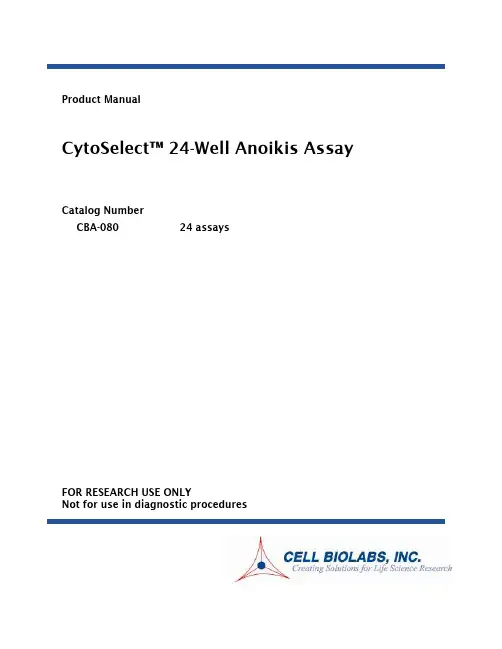
Product ManualCytoSelect™ 24-Well Anoikis AssayCatalog NumberCBA-080 24 assaysFOR RESEARCH USE ONLYNot for use in diagnostic proceduresIntroductionAdhesion to the extracellular matrix (ECM) is essential for survival and propagation of many adherent cells. Apoptosis that results from the loss of cell adhesion to the ECM, or inappropriate adhesion is defined as “anoikis”. Anoikis, from the Greek word for homelessness, is involved in the physiological processes of tissue renewal and cell homeostasis.A common feature of carcinoma development and growth is the ability of transformed cells to survive under “anchorage independent” or “spheroid” growth conditions. This resistance to anoikis has been shown to be involved in the loss of cell homeostasis, cancer growth, and metastasis. The inhibition of cell adhesion, spreading, and growth on the ECM is an impediment to the cellular healing process, thus making it a possible therapeutic target. Preventing anoikis and enhancing cell adhesion and spreading is a major goal in the development of cell transplantation techniques, including the therapeutic use of progenitor cells. Further studies aimed at controlling the molecular mechanisms of anoikis resistance will serve to define effective therapies for the treatment of many human malignancies.The CytoSelect™ 24-well Anoikis Assay Kit provides a colorimetric and fluorometric format to measure anchorage-independent growth and monitoring anoikis propelled cell death. The kit contains sufficient reagents for the assay of 24 samples in a Poly-Hema coated 24-well plate. Live cells are detected with MTT or Calcein AM. Cell death is detected with the Ethidium Homodimer (EthD-1). Assay PrincipleCells are cultured in poly-Hema coated plate or control plate. Cell viability is determined by MTT or Calcein AM. Anoikis propelled cell death is measured by Ethidium Homodimer (EthD-1). EthD-1 is an excellent marker for measuring dead cells. EthD-1 is a red fluorescent dye that can only penetrate damaged cell membranes. EthD-1 will fluoresce with a 40-fold enhancement upon binding ssDNA, dsDNA, RNA, oligonucleotides, and triplex DNA. Background fluorescence levels are very low because the dyes are virtually non-fluorescent before interacting with cells.Related Products1.CBA-081: CytoSelect™ 96-Well Anoikis Assay2.CBA-230: Cellular Senescence Detection Kit (SA-β-Gal Staining)3.CBA-231: 96-Well Cellular Senescence Assay (SA β-Gal Activity)4.CBA-232: Quantitative Cellular Senescence Assay (SA β-Gal)5.CBA-240: CytoSelect™ Cell Vi ability and Cytotoxicity AssayKit Components1.Anchorage Resistant Plate (Part No. 108001): One 24-well Poly-Hema coated plate.2.Calcein AM (500X) (Part No. 108002): One vial – 50 µL in DMSO.3.Ethidium Homodimer (EthD-1) (500X) (Part No. 108003): One vial – 50 µL.4.Detergent Solution (Part No. 108004): One bottle – 25.0 mL.5.MTT Solution (Part No. 113502): Three tubes – 1.0 mL each.Materials Not Supplied1.Cells for measuring anoikis2.Cell culture medium3.Inverted fluorescence/light microscope4.Fluorometer capable of reading Calcein AM (485 nm/515 nm) and EthD-1 (525 nm/590 nm)fluorescence.StorageStore the Calcein AM and Ethidium Homodimer at -20ºC. Store all other components at 4ºC.Assay Protocol1.Prepare a cell suspension containing 0.1-2.0 x 106 cells/ml in culture media. Cells can be treatedwith anoikis enhancing or inhibiting reagents.2.Add 0.5 mL cell suspension to each well of the Anchorage Resistant Plate or a control 24-well cellculture plate. Culture the cells 24-72 hours at 37ºC and 5% CO2. The time and culture conditions will depend on the cell line used and may need to be adjusted by the user.3.Proceed with MTT Colorimetric or Calcein AM/EthD-1 Fluorometric detection.MTT Colorimetric Detection1.Add the 50 µL of the MTT Reagent to each well of the Anchorage Resistant Plate or control 24-well plate.2.Incubate the wells 2-4 hours or overnight at 37ºC. Monitor the cells occasionally with an invertedmicroscope for the presence of a purple precipitate.3.Add 500 µL of Detergent Solution to each well. Gently mix the solution by pipetting.4.Cover the plate to protect it from light and incubate in the dark for 2-4 hours at room temperature.5.Transfer 200 µL to a 96-well plate and measure the absorbance in each well at 570 nm in amicrotiter plate reader.Calcein AM / EthD-1 Fluorometric Detection1.Add 1 µL of Calcein AM (500X) and 1 µL of Eth-D1 (500X) to each well of the 24-wellAnchorage Resistant Plate or control plate to be detected.2.Incubate the plate 30-60 minutes at 37ºC.3.Monitor the cells microscopically for the presence of the green Calcein AM (Ex: 485 nm and Em:515 nm) or red EthD-1 (Ex: 525 nm and Em: 590 nm) fluorescence. The fluorescence can be quantitatively measured with a fluorescence microplate reader.Example of Results The following figures demonstrate typical results with the CytoSelect™ 24-well Anoikis Assay Kit. One should use the data below for reference only. This data should not be used to interpret actual results.00.20.40.60.8Control Poly-HemaO D 560 n mFigure 1. Anoikis Assay of Human Foreskin Fibroblast BJ-TERT Cells. BJ-TERT cells were seeded at 50,000 cells/well in a tissure culture control plate or a Poly-Hema coated plate. Cells were allowed to culture for 24 hours. Cell viability was determined by MTT and Calcein AM, while anoikis-like cell death was stained with EthD-1.References1.Bates RC, Buret A, van Helden DF, Horton MA, Burns GF. (1994) J Cell Biol125, 403-415.2.Frisch SM, Francis H. (1994) J Cell Biol124, 619-626.3.Frisch SM, Screaton RA. (2001) Curr Opin Cell Biol13, 555-562.4.Meredith JE, Jr Fazeli B, Schwartz MA. (1993) Mol Biol Cell 4, 953-961.5.Rak J, Mitsuhashi Y, Erdos V, Huang SN, Filmus J, Kerbel RS. (1995) J Cell Biol131, 1587-1598. Recent Product Citations1.Mao, C.G. et al. (2021). BCAR1 plays critical roles in the formation and immunoevasion ofinvasive circulating tumor cells in lung adenocarcinoma. Int J Biol Sci. 17(10):2461-2475.doi:10.7150/ijbs.61790.2.Zheng, J.L. et al. (2021). Ursolic acid induces apoptosis and anoikis in colorectal carcinoma RKOcells. BMC Complement Med Ther. 21(1):52. doi: 10.1186/s12906-021-03232-2.3.Liu, L.Q. et al. (2019). MiR-92a antagonized the facilitation effect of extracellular matrix protein 1in GC metastasis through targeting its 3'UTR region. Food Chem Toxicol. 133:110779. doi:10.1016/j.fct.2019.110779.4.Xu, J. et al. (2019). ProNGF siRNA inhibits cell proliferation and invasion of pancreatic cancercells and promotes anoikis. Biomed Pharmacother. 111:1066-1073. doi:10.1016/j.biopha.2019.01.002.5.Tan, Y. et al. (2018). Adipocytes fuel gastric cancer omental metastasis via PITPNC1-mediatedfatty acid metabolic reprogramming. Theranostics. 8(19):5452-5468. doi: 10.7150/thno.28219. 6.Hu, L. et al. (2018). G9A promotes gastric cancer metastasis by upregulating ITGB3 in a SETdomain-independent manner. Cell Death Dis. 9(3):278. doi: 10.1038/s41419-018-0322-6.7.Hu, B. et al. (2018). Herbal formula YGJDSJ inhibits anchorage-independent growth and inducesanoikis in hepatocellular carcinoma Bel-7402 cells. BMC Complement Altern Med. 18(1):17. doi:10.1186/s12906-018-2083-2.8.Chen, H.Y. et al. (2018). Integrin alpha5beta1 suppresses rBMSCs anoikis and promotes nitricoxide production. Biomed Pharmacother. 99:1-8. doi: 10.1016/j.biopha.2018.01.038.9.Fu, X.T. et al. (2018). MicroRNA-30a suppresses autophagy-mediated anoikis resistance andmetastasis in hepatocellular carcinoma. Cancer Lett. 412:108-117. doi:10.1016/j.canlet.2017.10.012.10.Yu, M. et al (2017). Interference with Tim-3 protein expression attenuates the invasion of clear cellrenal cell carcinoma and aggravates anoikis. Mol Med Rep. 15(3):1103-1108. doi:10.3892/mmr.2017.6136.11.Lu, S. et al. (2016). Expression of α-fetoprotein in gastric cancer AGS cells contributes to invasionand metastasis by influencing anoikis sensitivity. Oncol Rep.35:2984-2990.12.Lee, H.W. et al. (2013). Tpl2 kinase impacts tumor growth and metastasis of clear cell renal cellcarcinoma. Mol Cancer Res.11:1375-1386.13.Sisto, M. et al. (2009). Fibulin-6 expression and anoikis in human salivary gland epithelial cells:implications in Sjogren's syndrome. Int. Immunol.21:303-311.14.Liu, H. et al. (2008). Cysteine-rich protein 61 and connective tissue growth factor induce de-adhesion and anoikis of retinal pericytes. Endocrinology 149:1666-1677.WarrantyThese products are warranted to perform as described in their labeling and in Cell Biolabs literature when used in accordance with their instructions. THERE ARE NO WARRANTIES THAT EXTEND BEYOND THIS EXPRESSED WARRANTY AND CELL BIOLABS DISCLAIMS ANY IMPLIED WARRANTY OF MERCHANTABILITY OR WARRANTY OF FITNESS FOR PARTICULAR PURPOSE. CELL BIOLABS’ sole obligation and purchaser’s exclusive remedy for breach of this warranty shall be, at the option of CELL BIOLABS, to repair or replace the products. In no event shall CELL BIOLABS be liable for any proximate, incidental or consequential damages in connection with the products.Contact InformationCell Biolabs, Inc.7758 Arjons DriveSan Diego, CA 92126Worldwide: +1 858-271-6500USA Toll-Free: 1-888-CBL-0505E-mail: ********************©2007-2021: Cell Biolabs, Inc. - All rights reserved. No part of these works may be reproduced in any form without permissions in writing.。
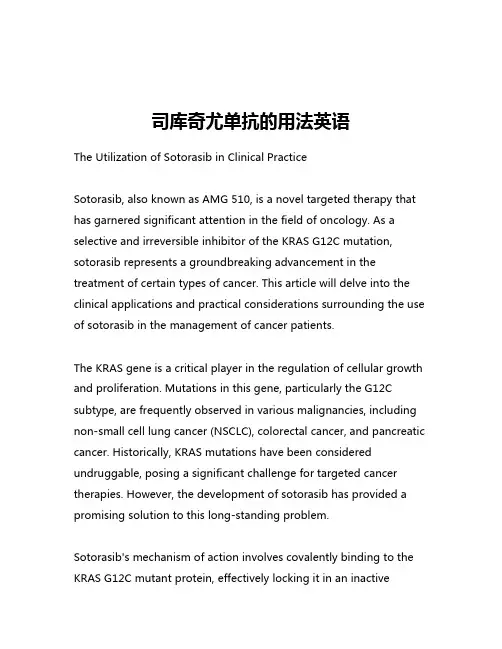
司库奇尤单抗的用法英语The Utilization of Sotorasib in Clinical PracticeSotorasib, also known as AMG 510, is a novel targeted therapy that has garnered significant attention in the field of oncology. As a selective and irreversible inhibitor of the KRAS G12C mutation, sotorasib represents a groundbreaking advancement in the treatment of certain types of cancer. This article will delve into the clinical applications and practical considerations surrounding the use of sotorasib in the management of cancer patients.The KRAS gene is a critical player in the regulation of cellular growth and proliferation. Mutations in this gene, particularly the G12C subtype, are frequently observed in various malignancies, including non-small cell lung cancer (NSCLC), colorectal cancer, and pancreatic cancer. Historically, KRAS mutations have been considered undruggable, posing a significant challenge for targeted cancer therapies. However, the development of sotorasib has provided a promising solution to this long-standing problem.Sotorasib's mechanism of action involves covalently binding to the KRAS G12C mutant protein, effectively locking it in an inactiveconformation. This inhibition of the mutant KRAS protein disrupts the downstream signaling cascades that drive uncontrolled cell growth and proliferation, ultimately leading to tumor cell death. The selectivity of sotorasib for the G12C mutation is a key advantage, as it minimizes the impact on wild-type KRAS and potentially reduces the risk of off-target effects.Clinical Trials and Regulatory ApprovalThe efficacy and safety of sotorasib have been extensively evaluated in various clinical trials. The landmark CodeBreaK 100 study, a phase II clinical trial, enrolled patients with KRAS G12C-mutated advanced NSCLC who had received prior systemic therapy. The results of this study were highly promising, with an overall response rate of 37.1% and a median progression-free survival of 6.8 months. These findings led to the accelerated approval of sotorasib by the U.S. Food and Drug Administration (FDA) in May 2021 for the treatment of adult patients with KRAS G12C-mutated locally advanced or metastatic NSCLC who have received at least one prior systemic therapy.Beyond NSCLC, sotorasib is also being investigated for its potential in other KRAS G12C-driven malignancies. The CodeBreaK 101 study is currently evaluating the efficacy and safety of sotorasib in patients with KRAS G12C-mutated colorectal cancer, pancreatic cancer, and other solid tumors. Preliminary data from this study have shown encouraging results, suggesting that sotorasib may have broaderclinical applications beyond NSCLC.Practical Considerations in the Use of SotorasibThe integration of sotorasib into clinical practice requires careful consideration of several key factors. Firstly, the identification of the KRAS G12C mutation is essential for patient selection. This is typically done through molecular testing, such as next-generation sequencing or real-time PCR, which should be performed on tumor tissue or liquid biopsy samples. Clinicians must ensure that the appropriate testing is conducted and the results are available before initiating sotorasib treatment.Dosing and administration of sotorasib also warrant attention. The recommended dosage is 960 mg taken orally once daily, with or without food. Patients should be advised to take the medication at the same time each day to maintain consistent drug levels. Monitoring for potential adverse events, such as diarrhea, fatigue, and liver function abnormalities, is crucial, and appropriate management strategies should be implemented as needed.Another important consideration is the management of patients with comorbidities or concomitant medications. Sotorasib is primarily metabolized by the CYP3A4 enzyme, and its interaction with other drugs that are substrates, inducers, or inhibitors of this enzyme should be carefully evaluated. Dose adjustments or alternativetreatment options may be necessary in such cases to ensure optimal therapeutic outcomes and minimize the risk of drug interactions.Lastly, the integration of sotorasib into the broader treatment landscape is crucial. Clinicians should consider the patient's overall disease status, prior therapies, and the potential for combination approaches. The role of sotorasib within the comprehensive management plan, including its sequencing with other targeted therapies, chemotherapy, or immunotherapy, should be carefully evaluated to optimize patient outcomes.ConclusionThe introduction of sotorasib represents a significant advancement in the treatment of KRAS G12C-mutated cancers. Its selective and irreversible inhibition of the KRAS G12C mutation has demonstrated promising clinical efficacy, particularly in the management of NSCLC. As clinicians navigate the integration of sotorasib into their practice, careful patient selection, appropriate dosing and administration, vigilant monitoring, and the consideration of comorbidities and drug interactions are essential. By leveraging the potential of this targeted therapy, healthcare providers can offer improved outcomes and enhanced quality of life for patients with KRAS G12C-driven malignancies.。
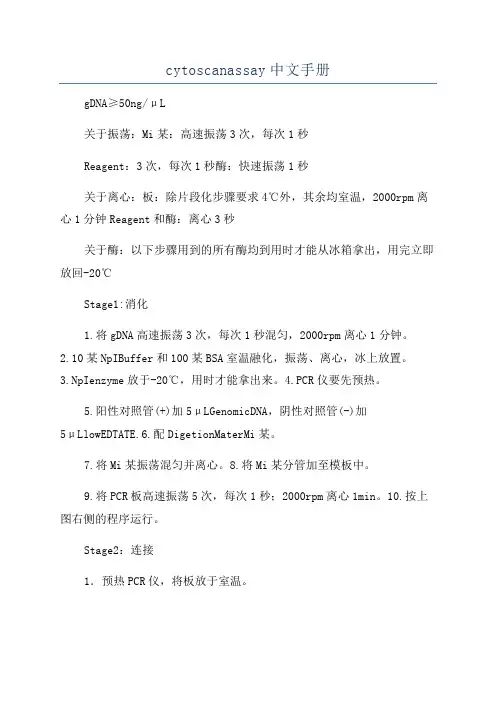
cytoscanassay中文手册gDNA≥50ng/μL关于振荡:Mi某:高速振荡3次,每次1秒Reagent:3次,每次1秒酶:快速振荡1秒关于离心:板:除片段化步骤要求4℃外,其余均室温,2000rpm离心1分钟Reagent和酶:离心3秒关于酶:以下步骤用到的所有酶均到用时才能从冰箱拿出,用完立即放回-20℃Stage1:消化1.将gDNA高速振荡3次,每次1秒混匀,2000rpm离心1分钟。
2.10某NpIBuffer和100某BSA室温融化,振荡、离心,冰上放置。
3.NpIenzyme放于-20℃,用时才能拿出来。
4.PCR仪要先预热。
5.阳性对照管(+)加5μLGenomicDNA,阴性对照管(-)加5μLlowEDTATE.6.配DigetionMaterMi某。
7.将Mi某振荡混匀并离心。
8.将Mi某分管加至模板中。
9.将PCR板高速振荡5次,每次1秒;2000rpm离心1min。
10.按上图右侧的程序运行。
Stage2:连接1.预热PCR仪,将板放于室温。
2.10某T4DNALigaeBuffer(约20min)和50μMAdaptor,NpI室温融化,振荡混匀,buffer变清澈,离心,冰上放置。
3.消化后的模板2000rpm离心1min,冰上放置。
4.配LigationMaterMi某.5.Mi某高速振荡3次,每次1秒;离心3秒。
6.将连接Mi某分至各消化管。
7.将PCR板高速振荡5次,每次1秒;2000rpm离心1min。
8.按上图右侧的程序运行。
Stage3A:PCR1.连接产物盖紧盖口,2000rpm离心1min。
2.稀释连接产物。
3.盖紧盖口,高速振荡5次,2000rpm离心1min,冰上放置。
4.稀释后的PCR产物每个模板分成4管,每管10μL。
如下图5.PCR仪预热。
6.10某TITANIUMTaqPCRBuffer,dNTPMi某ture,PCRPrimer002室温融化,混匀并离心,立即置于冰上。
luciferase reporter assays 实验流程Luciferase reporter assays 实验流程Luciferase reporter assays 是一种常用的荧光素酶基因实验技术,通常被用于研究基因的调控情况和信号转导通路,具有灵敏度高、便利快捷和精确可靠等优点。
下面是一个标准的 luciferase reporter assays 实验流程,供读者参考和学习。
实验前的准备工作在开始实验前,要做好以下准备工作:1. 克隆目标基因的启动子区域至质粒的多克隆位点中,构建基因报告载体。
2. 扩增荧光素酶基因(luciferase)并插入其单元序列到构建的基因报告载体中。
3. 转化宿主细胞,如 HEK293 或 HEK293T 等胚胎肾细胞,用于后续的转染实验。
实验步骤1. 细胞培养与转染a. 在超声波弄碎的酵母提取物或所需药物(如激酶活化剂或抑制剂等)的存在下将宿主细胞培养至密度达到 70%至 80%,以进行下一步转染实验。
b. 制备含有报告载体和常见质粒的转染介质,如Lipofectamine 或 PEI。
c. 按照转染介质的使用说明,将报告载体和常见质粒与转染介质混合,转染至预处理的宿主细胞中。
d. 转染海马素(海马素)或质粒工程的抗生素进行筛选,直到达到足够的表达水平,通常需要约 24 至 48 小时才能达到高度表达。
2. 收集与清洗宿主细胞a. 收集已转染宿主细胞到新鲜装填透明微孔板的生长培养物中。
b. 从培养基中移除转染介质及海马素或抗生素,洗涤一次,然后添加新的培养基并在 24 小时后评估其是否可以进行 luciferase reporter assays 实验。
3. 荧光素酶的分析a. 在室温下加入 luciferase 补体混合物,立即测量底物的荧光信号,并记录荧光强度。
b. 在测量荧光信号前,请检查底物对 luciferase 具有的最大荧光响应值,协定它的上限响应值。
DOI:10.16662/ki.1674-0742.2021.10.006肺活检术联合快速现场细胞学评价(C-ROSE)在肺部阴影病变诊断价值张炜,王玉梅,李森龙,郭丽华,施恋南方科技大学医院呼吸内科,广东深圳518055[摘要]目的探讨肺活检术联合快速现场细胞学评价(C-ROSE)在肺部阴影诊断中的应用价值。
方法回顾性分析2018年3月—2020年8月影像学提示疑难肺部阴影的患者81例(排除肿瘤),气管镜肺活检77例,CT引导穿刺4例,将其按照是否进行快速现场细胞学评价(C-ROSE)分为两组,其中C-ROSE组39例,非C-ROSE组42例。
以术后常规细胞及组织学病检结果为金标准。
结果良性病变C-ROSE组确诊率为92%。
非C-ROSE组确诊率为76%。
两组差异有统计学意义(χ2=3.899,P=0.048)。
经支气管镜肺活检术联合C-ROSE组确诊率为91%,非C-ROSE组确诊率为76%,两组差异无统计学意义(χ2=3.159,P=0.076)。
结论肺活检技术(经支气管镜肺活检及经皮肺穿)联合快速现场细胞学评价(C-ROSE)对肺部疑难良性病变的确诊率高,有效可靠;经支气管镜肺活检术联合C-ROSE阳性率高于非ROSE组,但没有诊断学意义。
快速现场细胞学评价作为支气管镜检查辅助手段,值得基层医院临床推广应用。
[关键词]快速现场细胞学评价;经支气管镜肺活检术;经皮穿刺肺活检术;肺疾病;诊断[中图分类号]R563[文献标识码]A[文章编号]1674-0742(2021)04(a)-0006-03The Value of Lung Biopsy Combined with Rapid on-site Cytological Evaluation(C-ROSE)in the Diagnosis of Shadowed Lung LesionsZHANG Wei,WANG Yumei,LI Senlong,GUO Lihua,SHI LianDepartment of Respiratory Medicine,Southern University of Science and Technology Hospital,Shenzhen,Guangdong Province,518055China[Abstract]Objective To explore the application value of lung biopsy combined with rapid on-site cytological evaluation (C-ROSE)in the diagnosis of lung shadows.Methods A retrospective analysis of81patients with difficult lung shadows revealed by imaging findings from March2018to August2020(tumor excluded),77cases of bronchoscopy lung biopsy,and 4cases of CT-guided puncture were analyzed according to whether the rapid on-site cell was performed.Scientific evaluation(C-ROSE)was divided into2groups,including39cases in the C-ROSE group and42cases in the non-C-ROSE group.The results of postoperative routine cell and histological examinations are the gold standard.Results The diagnosis rate of benign lesions in the C-ROSE group was92%.The diagnosis rate in the non-C-ROSE group was76%.The difference between the two groups was statistically significant(χ2=3.899,P=0.048).The diagnosis rate of bronchoscopy lung biopsy combined with C-ROSE group was91%,and the diagnosis rate of non-C-ROSE group was76%.The difference between the two groups was not statistically significant(χ2=3.159,P=0.076).Conclusion Lung biopsy technology (bronchoscopic lung biopsy and percutaneous lung biopsy)combined with rapid on-site cytological evaluation(C-ROSE)has a high diagnostic rate for difficult and benign lung lesions,and is effective and reliable;bronchoscopy lung biopsy combined with C-ROSE positive rate is higher than that of non-ROSE group,but it has no diagnostic significance.Rapid on-site cytology evaluation as an auxiliary method of bronchoscopy is worthy of clinical application in primary hospitals.[Key words]Rapid on-site cytological evaluation;Transbronchoscope lung biopsy;Percutaneous lung biopsy;Lung disease; Diagnosis[基金项目]深圳市南山区技术研发和创意设计项目分项资金教育(卫生)科技资助项目(南科研卫2018062号)。
GDG 5-13-04In vivo CTL Protocol(protocol from J. Bennet, who got it from M. Teague, who got it from Byers/Barber)4/19/041.Sac donors and prepare splenocytes.2.Counts cells and divide into 2 tubes, each in 10 mls of media.3.Add 5 μM peptide of interest to one tube, 5 μM of irrelevant peptide to the other.Tube A – 14.34 ul of 3mg/ml MOG35-55 into 10 mls.Tube B – 100 ul of 0.5mM OVA 323-339 into 10 mls4.Incubate in these tubes at 37︒C, 5% CO2 for 90 minutes to label targets.5.Wash cells 4x with DMEM/10% serum.6.Wash 1x with PBS. These washes are IMPORTANT!!7.Resuspend cells in 10 mls of PBS and differentially CFSE label the 2populations:a.For 2 μM CFSE, add 2.2 μl of 10 mM CFSE to 11 ml of PBS.b.Dilute 1 ml 10-fold in PBS for 0.2 uM CFSE.c.Add 10 mls of a stain mix to each tube containing 10 mls of cells in PBSfor final concentrations of 1 μM and 0.1 uM CFSE in 20 mls.d.Incubate at 37︒C for 10 minutes8.Stop reaction by adding 2 mls of FBS to the 20 mls.9.Wash cells 1x with DMEM/10% FBS .10.Wash 2x with PBS.11.Filter cells and count.12.Mix equal numbers of each population of cells.13.Resuspend 1.5x107 cells/ml in PBS and inject 400 μl of cells ( =6x106 cells) permouse.a.Remember to plate one well of uninjected cells.14.Incubate in vivo for appropriate amount of time – will start to see significantkilling about 5 hours after injection.15.At desired timepoint, sac each recipient, prepare splenocytes, and stain cells.16.FACS: Collect at least 1x106 events per samples, gate on CFSE+ cells foranalysis.17.To determine percent killing;User percentages of peptide – loaded and irrelevant peptide loaded cellsrecovered from naïve mouse:Adjustment Factor A = %peptide / %irrelevant peptideUse adjustment factor to determine exact killing in immunized mice: Percent Killing = (%irrelevant killing x A) – peptide% irrelevant peptide x A。
HLA-Ⅰ基于细胞的多肽竞争结合试验Competition-Based Cellular Peptide Binding Assay for HLA Class I Competition-Based Cellular Peptide Binding Assays for 13 Prevalent HLA Class I Alleles UsingFluorescein-Labeled Synthetic Peptides这是与免疫原性相关的第3篇文章,前两篇分别是多肽药物及其杂质的免疫原性的计算机预测和含有非天然氨基酸的多肽及其杂质的免疫原性的计算机预测。
基于计算机算法的预测虽然取得了极大的发展并很好的帮助了我们研究免疫原性,但是仍然还没有达完全可以取代实验测定的程度。
多肽的免疫原性在经过计算机预测后,对于预测显示具有较高免疫原性的肽序,应当进行试验测定其与HLA的结合亲和力。
此次分享介绍了基于细胞的测定多肽与HLA结合亲和力的一种方法。
文献仅限于知识传播,不作他用,侵删。
摘要在本文中报告了13种主流的HLA-Ⅰ分子基于竞争法的多肽结合试验的建立、验证和应用。
该检测方法是基于多肽与携带特定等位基因的活细胞上的HLA分子的结合。
通过测试多肽与荧光标记的HLA-Ⅰ型分子结合肽的竞争作为试验结果的显示。
此次试验的13种HLA 等位基因分别是:HLA-A1、HLA-A11、HLA-A24、HLA-A68、HLA-B7、HLA-B8、HLA-B14、HLA-B35、HLA-B60、HLA-B61、HLA-B62、HLA-A2和HLA-A3,这13种主流的等位基因涵盖了95%的高加索人群。
通过这项试验,我们从HIV肽库、P53、PRAME,以及次要组织相容性抗原HA-1库中鉴定到了HLA-Ⅰ高亲和力的肽。
因此这项便利且准确的多肽结合试验将有助于鉴定在不同HLA-Ⅰ型分子上假定的细胞毒性T淋巴细胞表位。
介绍HLA限制性细胞毒性T淋巴细胞表位(CTL)的鉴定对我们理解微生物或病毒感染,自身免疫疾病,癌症的免疫以及开发诱导CTL疫苗和此类免疫疗法的监测至关重要。
luciferase assay原理Luciferase assay原理引言:Luciferase assay是一种广泛应用于生物学研究中的实验技术,它基于荧光素酶(luciferase)催化底物产生可观测的荧光信号的原理。
这种技术在基因表达分析、蛋白质相互作用研究和药物筛选等领域都发挥着重要作用。
本文将详细介绍Luciferase assay的原理及其应用。
一、Luciferase assay的基本原理Luciferase assay的基本原理是利用荧光素酶催化底物发光的特性来检测目标生物分子的活性或表达水平。
荧光素酶是一种存在于许多生物体中的内源性酶,它能够氧化底物(如D-荧光素)产生光信号。
Luciferase assay通过向待测样品中添加荧光素底物,并测量产生的荧光信号的强度,来间接评估目标生物分子的活性或表达水平。
二、Luciferase assay的步骤1. 构建荧光素酶基因的表达载体:首先需要将荧光素酶基因克隆到一个适当的表达载体中,以便在细胞内高效表达。
这个载体通常包含一个启动子、转录终止子和荧光素酶基因的编码序列。
2. 转染细胞:将构建好的表达载体转染到目标细胞中,使细胞内产生荧光素酶。
3. 加入底物:加入荧光素底物,使荧光素酶与底物发生催化反应,产生荧光信号。
4. 测量荧光信号:使用荧光分析仪或荧光显微镜等设备,测量样品中产生的荧光信号的强度。
三、Luciferase assay的应用1. 基因表达分析:Luciferase assay可以用于研究基因的调控机制和功能。
通过将荧光素酶基因与目标基因的启动子或调控序列连接,可以检测到这些序列对基因表达的影响。
通过比较不同条件下荧光素酶活性的差异,可以评估目标基因的表达水平。
2. 蛋白质相互作用研究:Luciferase assay可以用于研究蛋白质的相互作用关系。
通过将荧光素酶基因与两个相互作用的蛋白质的编码序列连接,可以检测到这两个蛋白质的相互作用。
clauss法Clauss法(Clauss Assay)是目前血浆中凝血酶原(Fibrinogen)测定中最常用的方法之一。
其基本原理是通过凝血酶原的特异性、选择性和灵敏性来实现Fibrinogen的定量。
本文将从Clauss法的历史渊源、测定原理、操作方法以及应用范围等方面进行详细介绍。
一、历史渊源Clauss法的发明者是瑞士生物化学家Rolf Gruner (1921-1999)和美国生物化学家Karl Ludwig Clauss (1925-2000),他们两人都是卡尔斯鲁厄大学(University of Karlsruhe)的教授。
1957年,Gruner 和Clauss一起进行了一项关于血浆凝血因子的研究,他们尝试发现血浆中对凝血酶原的影响,并使用这种影响来确定Fibrinogen的量。
最终,他们建立了一种新的技术——Clauss法。
二、测定原理Clauss法测定Fibrinogen的原理是利用凝血酶原被凝血酶水解形成凝血纤维蛋白的特性。
当人体受到损伤后,凝血酶原被激活,产生的凝血酶将纤维原转变为纤维蛋白,形成凝块。
在Clauss法中,加入凝血酶使得凝血酶原被水解,而这个过程的速率和Fibrinogen的浓度成正比。
在实际操作中,将0.1 mL的稀释后的血浆样品与0.1 mL的0.02 mol/L CaCl2溶液混合,将混合物加入在37℃预热的玻璃管中,然后注入0.05 mL的人凝血酶溶液,同时使用琼脂法测定样品与人凝血酶混合后的凝块重量。
测定凝块重量与已知浓度Fibrinogen的标准品进行比较,从而计算出未知样品的Fibrinogen浓度。
三、操作方法1. 稀释血浆样品:将血浆样品稀释为适当的浓度,常见的是1:10、1:20 和1:40 三档。
多选择稀释质量值(比如0.2mL),计算出稀释液的体积,然后与样本一起混合。
2. 加入CaCl2溶液:在某些Clauss法的试剂盒中,CaCl2已经加入到了显色试剂中,因此不需要再单独加入CaCl2溶液。
CTL assays
1.2 流式细胞法
1.2.1 PE-mAb/FITC-annexin V 荧光标记法[3] 正常细胞的磷酯酰丝氨(phosphatidylserine,PS)位于细胞膜内表面,细胞凋亡时翻转露于膜外侧,可与annexinV 高亲合力结合。
研究发现PS外翻为细胞凋亡的早期事件,先于膜通透性增加所51Cr或其他染料的释放。
将效应细胞与靶细胞充分共育后,用PE结合的效应细胞特异性单克隆抗体(如CD8-PE)标记效应细胞(不能与PE-mABA结合的细胞即为靶细胞),再用FITC-annexin V标记凋亡靶细胞,用流式细胞仪区分并定量此三类不同的细胞群,即可计算出效应细胞杀伤靶细胞%。
本法①简单快捷,无需预标记,直接将上二试剂加入测定管即可;②与51Cr 法相关性好(r=0.989),在早期时段更为灵敏,还可在进行分析,尤其适用于动力学分析;
③可允许E与T长时间共育,对探讨E通过合成及分泌某些细胞因子(如TNF)而杀伤靶细胞的机理性研究特别有利;④可用荧光显微镜观察测定。
3 比色测定法
3.1 MTT(或MTS)还原法[8]
本法根据细胞代谢活动与活细胞数直接成比例的原理,通过测定靶细胞代谢活性的减少来反映效应细胞所致靶细胞的死亡。
氧化型MTT进入细胞后被线粒体脱氢酶还原生成蓝色formazan颗粒,经溶剂溶解后比色定量,其颜色深浅直接与活细胞数有关,与靶细胞对照孔比较可计算效应细胞杀伤靶细胞%。
本法简便易行,无需预标靶细胞,与51Cr释放法比较相关性好,还可测定淋巴细胞增殖活性和NK细胞活性。
MTT类似物MTS在细胞内还原的formazan产物具有水溶性,性质较稳定,其测定简单快捷,特别适合于大批量测定。
微生物污染可导致本法假阳性结果。
3.2 LDH释放法
酸脱氢酶(LDH)在胞浆内含量丰富,正常时不能通过细胞膜,当细胞受损伤或死亡时可释放到细胞外,此时细胞培养液中LDH活性与细胞死亡数目成正比,用比色法测定并与靶细胞对照孔LDH活性比较,可计算效应细胞对靶细胞的杀伤%。
本法操作简便快捷,自然释放率低,可用于CTL及NK细胞活性测定及药物、化学物质或放射引起的细胞毒性,现已有LDH法测定CTL活性试剂盒(promega)。
应注意较高浓度FCS中所含LDH可能干扰结果。